MADNESS OF THE CHURCH FATHERS: Virginity and Christianity
My previous blog post was based on a visit to a church near our home here in Rome. Even closer than San Damaso is an equally ugly building from the last century – Chiesa di Santa Maria Regina Pacis, built in 1942.

“Saint Mary, Queen of Peace” has its origins in a wooden sculpture that a certain Jean de Voisine gave to his wife in the early 16th century. In 1588, his nephew Henti Joyeuse inherited the sculpture, which, when he became a Capuchin monk in 1588, took with him to his monastery church in Paris. There it was christened as The Queen of Peace. The sculpture became wildly popular and people prayed in front of it to protect and preserve sons who had gone off to various wars. Soon, churches dedicated to Saint Mary, Queen of Peace had been erected in various parts of the world.
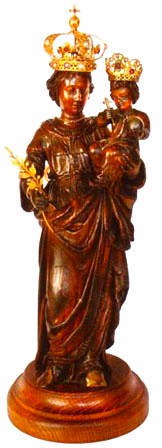
In addition to the French statuette, there is the marble sculpture that Guido Galli (1890-1944) created at the request of Pope Benedict XV to be placed in the Roman Basilica of the Madonna – Santa Maria Maggiore, to become a focal point for all the prayers addressed to her to end the carnage of the World War I. The sculpture was inaugurated on August 4, 1918, and peace was concluded on November 11 of the same year.
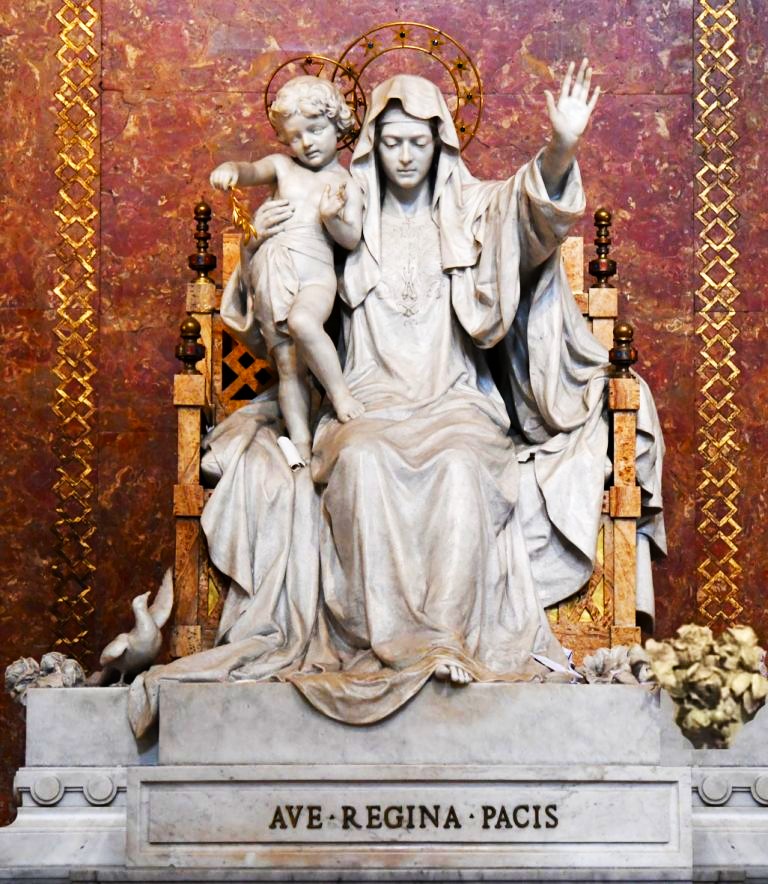
In the otherwise dreary Chiesa di Santa Maria Regina Pacis there is a mosaic of the Holy Mary Queen of Peace. She looks unusually youthful and cheerful and was created by an artist unknown to me, Odoardo Anselmi. The only information I have found about him is that he was born in 1916.
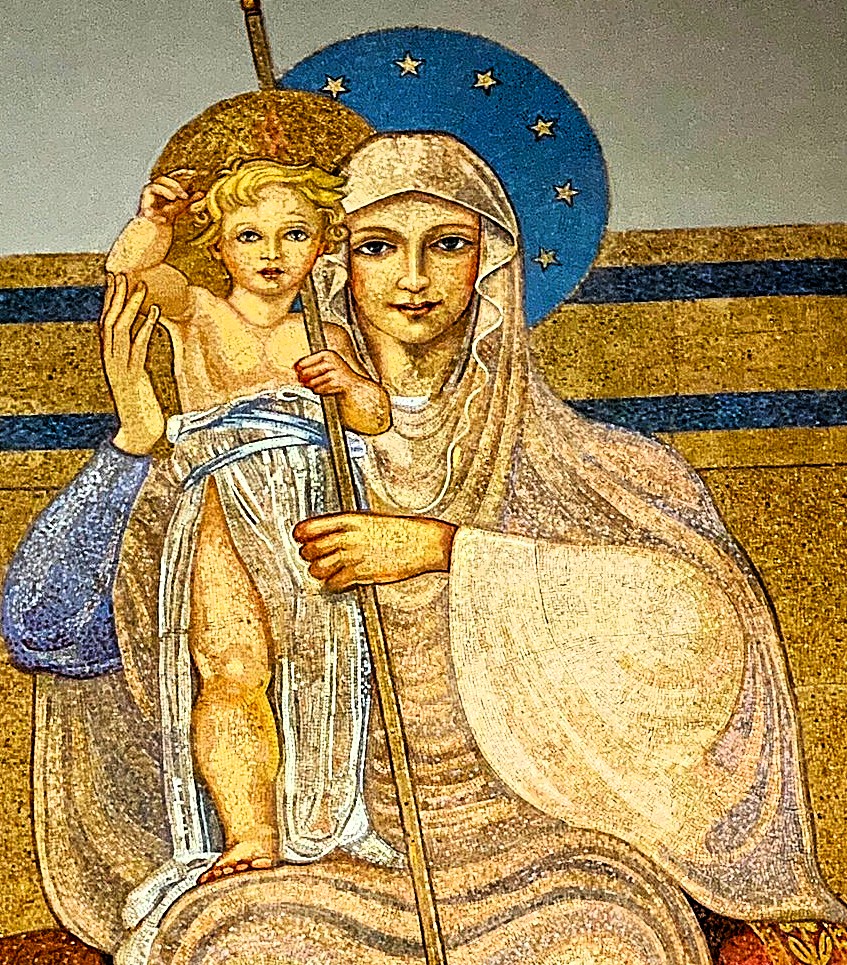
The Queen of Peace is on each side flanked by personifications of her attributes. On the right she is celebrated as the queen of patriarchs, virgins and apostles.
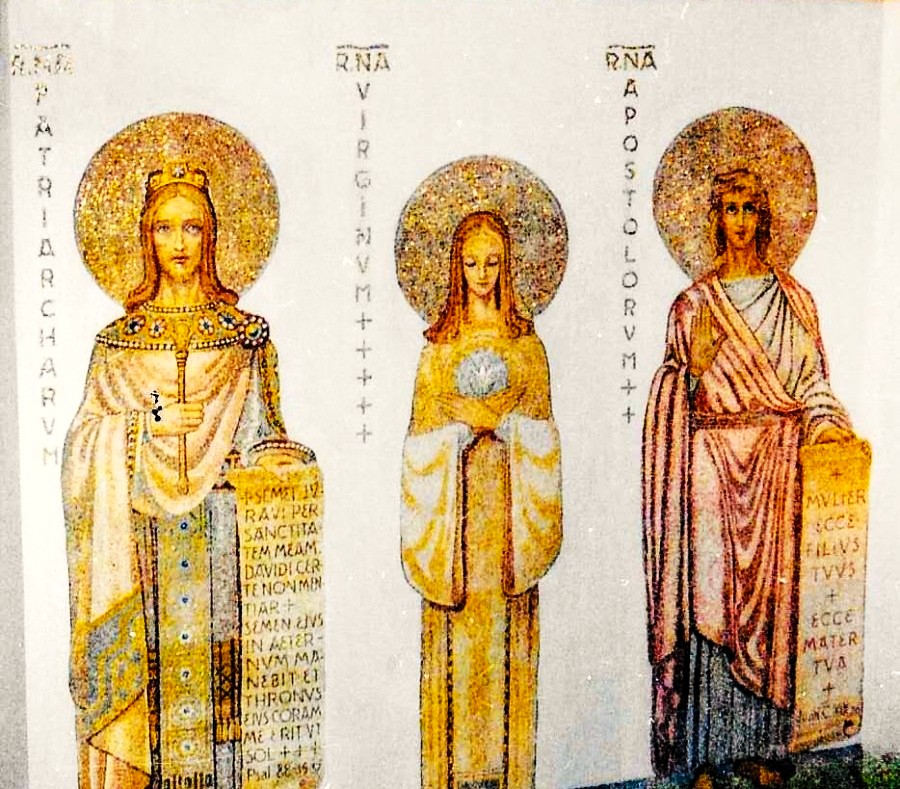
On her left she is the queen of prophets, martyrs and bishops.
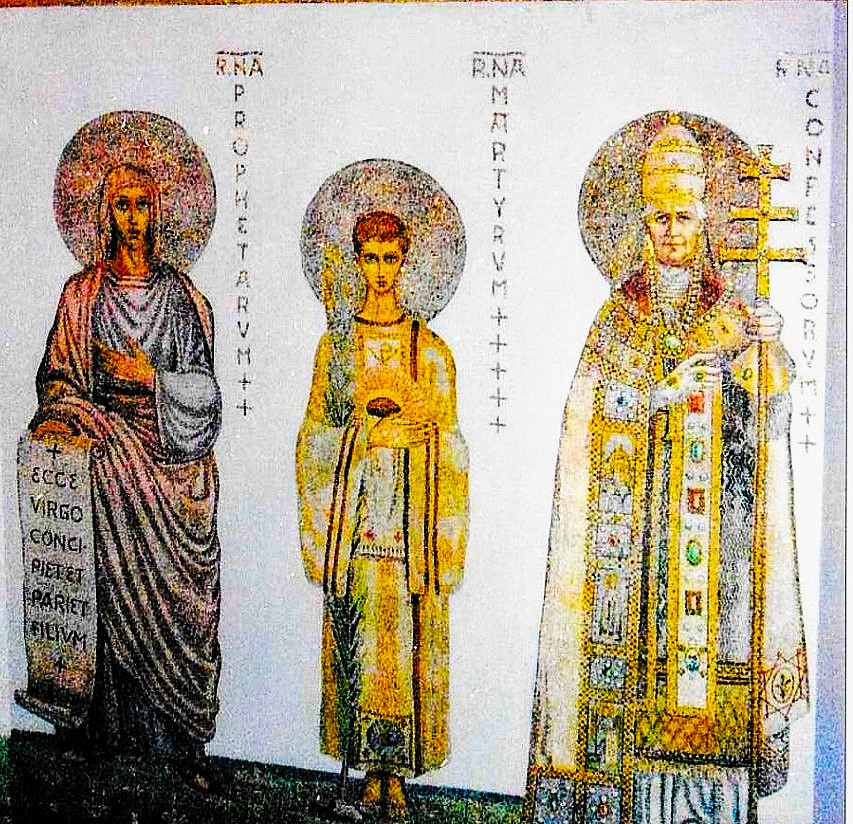
I stand in front of the mosaic depicting the Madonna as the queen of virgins and ponder why the Catholic Church, and to some extent also the Protestant Church, has placed so much importance on virginity. The word “virgin” actually means nothing more than “young lady”, probably connected with the concept vireo, to be “green, fresh, flourishing”. Since the New Testament written in Greek, it may be appropriate to derive the concept of virginity to parthénos “virgin, girl”, as well as “unmarried woman”.

The concept of parthénos was among both Greeks and Romans intimately associated with chastity, from the Latin word castus, “cut off, separated, pure”, and thus related to the concept of “sacred” related to the Latin sacrare “to separate, dedicate, consecrate”. Consequently, virginity became a social construct designating someone who had been “separated” in the sense that a virgin was a person/divinity who had not had any sexual intercourse. Although a man could also be considered to be a virgin, in the sense that he was sexually inexperienced, but the term mostly came to characterize young “untouched” women.
Virgin goddesses appear in several different religions. For example, several female gods in Greek and Roman mythology were assumed to have been eternally chaste. They could even, like Athena/Minerva, have arisen from parthenogenesis, a form of asexual reproduction, like Athena who had been born from the head of Zeus. But in some versions this may not have been a parthenogenesis in the strict sense of the word. Some myths claimed that Zeus swallowed Athena’s mother Metis. A being who was not actually a deity but a titan who became Zeus’ first wife. She was the wisest of both gods and titans and when she married Zeus it was predicted that she would give birth to a daughter who was as strong and powerful as her father. Zeus became worried, he did not want a rival who could join her mother and rebel against him. Accordingly, Zeus swallowed Metis so that she became a part of him. However, Zeus began to suffer from such an excruciating headache that he was forced to call upon his son Hermes, who in his turn asked Hephaestus, the blacksmith, to open Zeus’ skull and out came the fully armed Athena, goddess of wisdom, organized war, agriculture, households, industry, law, and justice.
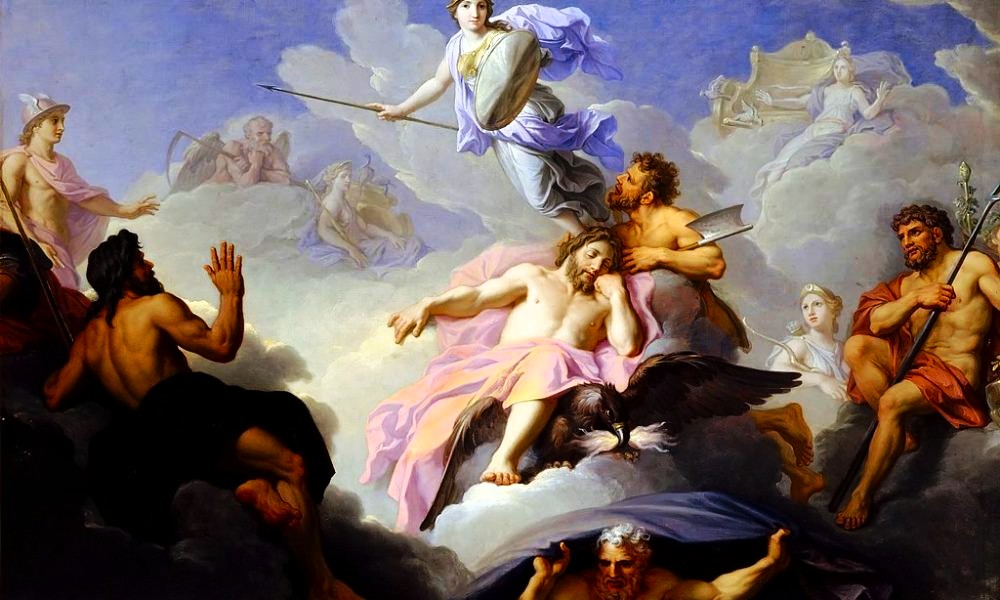
Other virgin goddesses were born in a more normal way. Hestia/Vesta was the sister of Zeus. She was goddess and protector of the sacrificial fire, the home, and the nation. As such, she was fully occupied and could not be bothered by other demanding interests; such as men and lovers. Hestia therefore swore eternal chastity and lived separated from male beings.
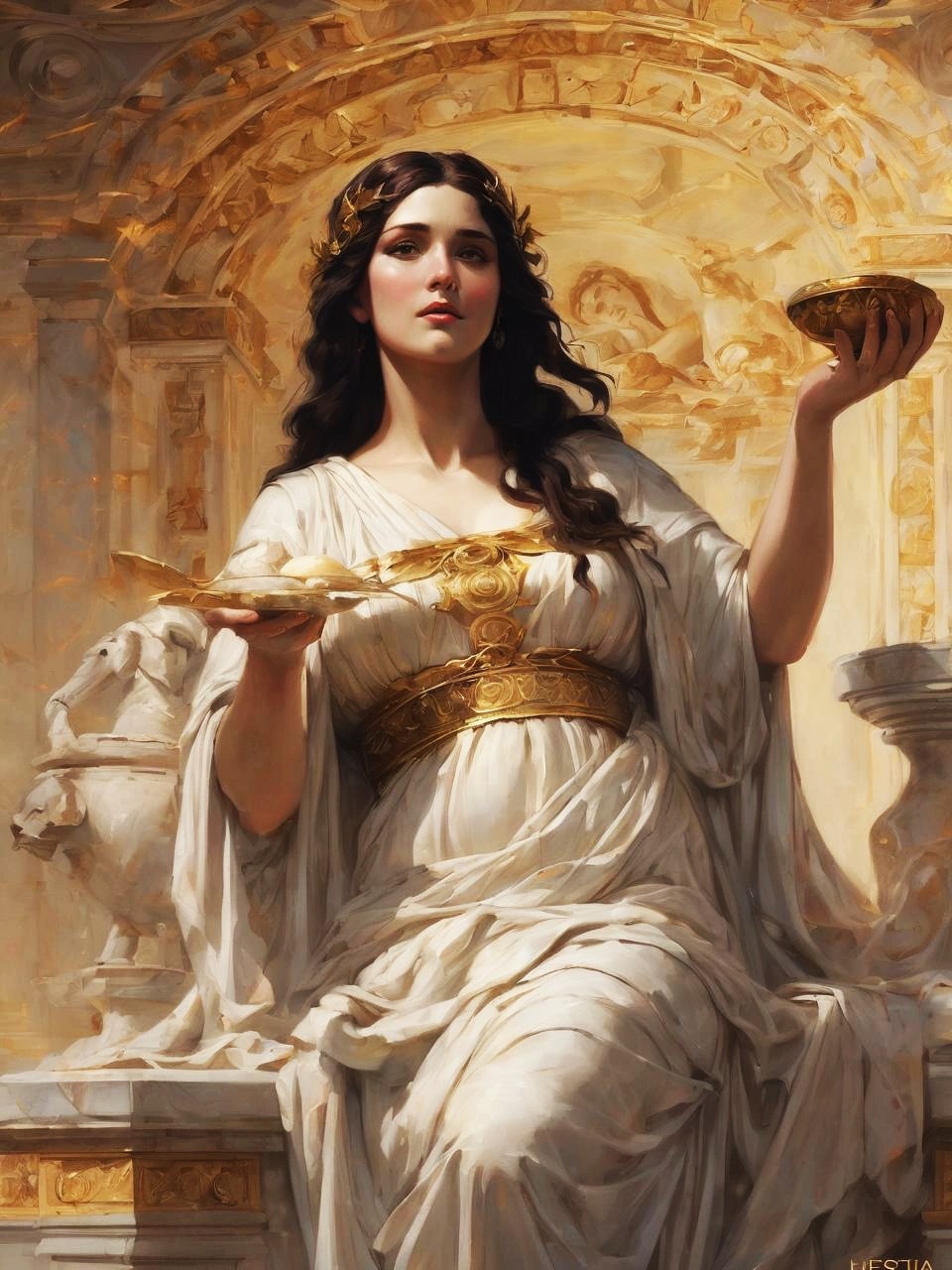
Daughter of Zeus and Apollo’s twin sister, the virgin Artemis/Diana, was goddess of hunting and the wilderness and accordingly wanted to be free and unbound, completely unmoved by male charm and scorning any marriage proposal. Her wild and unbound nature made her the cherished goddess of slaves and plebeians.

What these three of the most famous, ancient virgin goddesses had in common was that they raved about their virginity as a means for women to live unbound by the obligations involved with marriage. In the patriarchal societies where they were worshipped, women were subjugated to the power and authority of men. By being unbound outsiders, these virgin goddesses were perceived as particularly powerful and to some extent dangerously unpredictable forces, able to be used to intervene in an otherwise patriarchal world order.
Something that is particularly evident in the goddess of crossroads and black magic – Hekate, also an unbound virgin goddess, who was often invoked when it came to taking revenge through magical means, or demand a woman’s rights against male abuse.
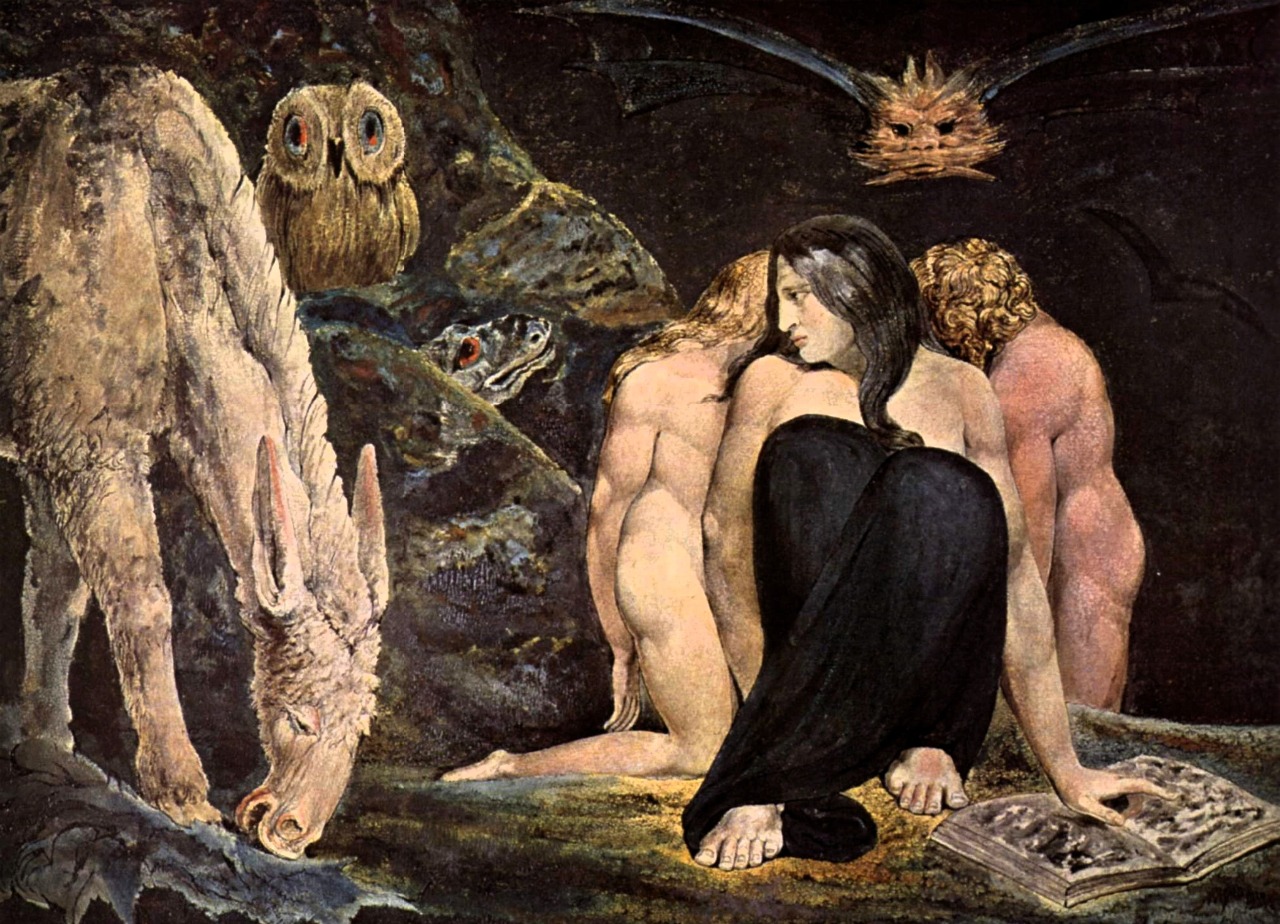
These beings were goddesses and it is doubtful whether people in general really believed that such divinities were moving among people, taking the form of real flesh and blood. If that happened, it could possibly be as in the Swedish poet Hjalmar Gullberg’s poem below, indicating that those who believed that Jesus was identical with God perhaps perceived his time on earth in a similar way.
Gods are still walking across this land.
One may be sitting at your right hand.
Don’t ever believe a god can die.
He’ll walk before you, but where is your eye?
No lyre has he, nor feet that’re purple shod.
It’s only through his actions that you know a god.
The rule is set and never is revised:
Is God on earth, he walks around disguised.
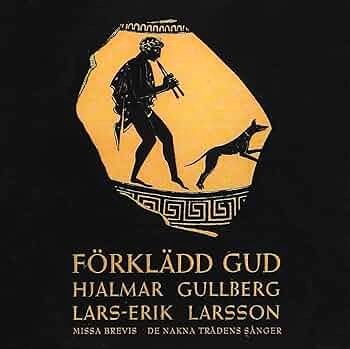
One thing was certain, and that was that no Christian doubted that Jesus had been a real person who at a given time lived among us humans, that many had met him and listened to him. There was no doubt that Jesus was born and died here on earth. However, it was regarding the real nature of this person that perceptions began to diverge early on. If he was God, how could Jesus have been born and died as an ordinary human being? It was a thorny question that had been present ever since Paul declared in his letter to Titus that Jesus would be resurrected and that he was in fact identical with God: “Our great God and Savior Jesus Christ will appear in all his glory.” However, it is doubtful whether Paul explicitly identified Jesus with God. In the his letter to the Colossians, Paul seems to regard Jesus as a god, but perhaps not God himself:
The Son is the image of the invisible God, the firstborn over all creation. For in him all things were created: things in heaven and on earth, visible and invisible, whether thrones or powers or rulers or authorities; all things have been created through him and for him.
Nor had Jesus explicitly said that he was God, although he gave plenty of allusions, perhaps not so much in the more down-to-earth, so-called synoptic gospels – Luke, Mark and Matthew – which all present similar accounts of Jesus’ life. Howvere, the more esoteric John is different, providing a more “theological” impression of Jesus’ life, with his numerous remarks beside Jesus’ tangible existence and statements. John has Jesus say “I and the Father are one”, “Very truly I tell you before Abraham was born, I am!”. Most crucial for all later speculations about the true nature of Jesus was the introduction to St John’s Gospel:
In the beginning was the Word, and the Word was with God, and the Word was God. He was with God in the beginning. Through Him all things were made, and without Him nothing was made that has been made. In Him was life, and that life was the light of men. The Light shines in the darkness, and the darkness has not overcome it. […] The Word became flesh and made His dwelling among us. We have seen His glory, the glory of the one and only Son from the Father, full of grace and truth.
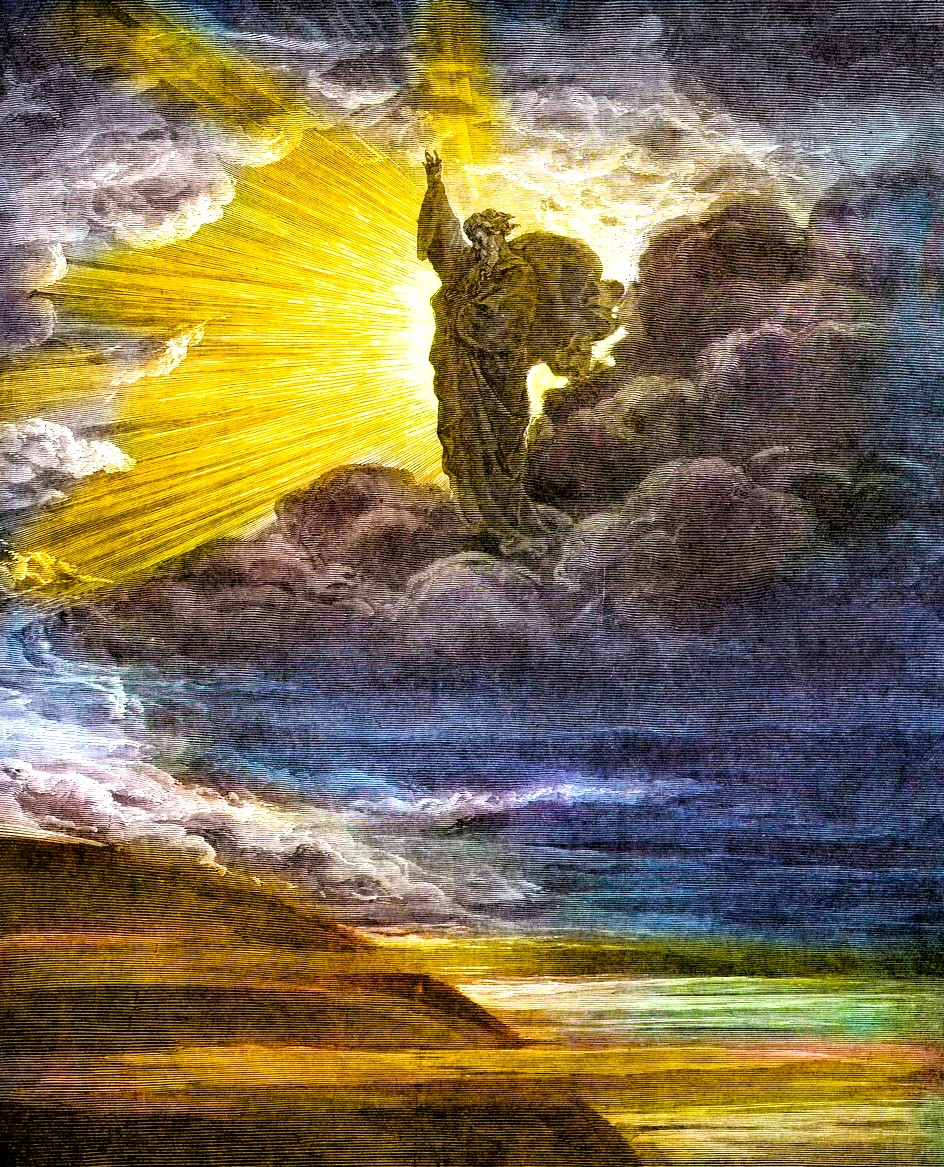
This introduction to the gospel was taken by most theologians as evidence for Jesus’ divine origin and that he took human form by being born of Mary, who never is mentioned by name in the Gospel of John. However, the synoptics tell us her name was mary but do not go into specifics about her virginity. The evangelists Luke and Matthew wrote that when the angel Gabriel announced to Mary that she would become pregnant by the Holy Spirit, she was still a virgin, but they do not go into any details about how the conception, pregnancy and birth took place. Luke writes, for example:
How can this be,” Mary asked the angel, “since I am a virgin?” The angel replied, “The Holy Spirit will come upon you, and the power of the Most High will overshadow you. So the Holy One to be born will be called the Son of God.
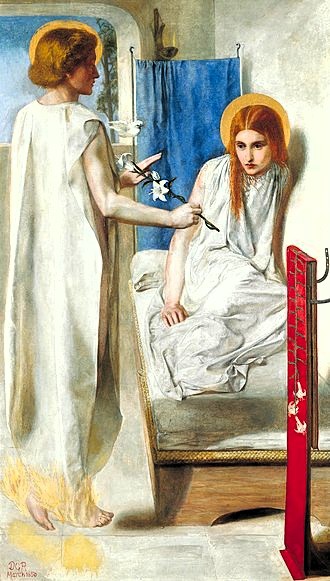
St. John is not only more enigmatic than the other evangelists, he is also more demanding:
There came a man who was sent from God. His name was John. He came as a witness to testify about the Light, so that through him everyone might believe. He himself was not the Light, but he came to testify about the Light.
It is perhaps not so strange that the theologians and philosophers of antiquity felt more attracted to John than to the other evangelists. In John's company, they began early on to speculate about questions such as “the true nature of Christ”, “Christ's relationship to the Father” and not least Mary’s virginity. Had she really given birth to a God? In that case, Jesus’ conception and birth could not have taken place in the usual manner.
Theological disputes about Mary’s virginity took as their starting point the intricate doctrine of original sin. Several Christians, in accordance with several Jewish scholars, had claimed that the world was evil and that all humans were born and live in sin. This was because we inherited our sinful state from Adam and Eve, who by eating the forbidden fruit of knowledge had gained the ability to choose between good and evil. When God found that they had broken his rules the first humans were expelled from his Paradise.
According to several theologians, this meant that none of us humans, either then nor now, through this so-called “fall” can realize what true righteousness is and thus have a distorted image of who God is and what He wants from us. Worst of all, this distance from God has caused us to fall into things that have nothing to do with Him, primarily corrupting lives characterized by a passion through which “animalistic, earthly lust” has taken over all reasoning, all godliness.
At first, it was mainly Gnosticism that took hold of this distinction between body and soul, between the earthly and the heavenly. Gnosticism was a collection of religious ideas and systems that by the end of the 1st century AD merged with the Christian sects. This complicated system of thought originated in various parts of the Roman Empire, perhaps primarily in Egypt and Syria, and had drawn inspiration from several sources – Greek philosophy, primarily Platonism, and not least Jewish, Syrian, Egyptian and Persian religious speculations, based on rites and religions that had gradually been transformed through increased communication and literacy.
In broad terms, Gnosticism might be schematically described as related to the idea of a Supreme Being, generally called the Monad, from which divine beings emanate, or they may rather be considered as a kind of personifications of various concepts. The Monad exists in a region of divine life, a luminous existence high above us (although this cannot be understood as a geographically limited reality). The aeons emanate from this Pleroma. One of these is Sophia – the Greek word for “wisdom”. She signifies the final emanation of the Monad and is identified with the Anima mundi, the World Soul. As such, Sophia created the flawed Demiurge, who became master of the material world and holds the souls of men captive there until we can regain our original divine knowledge – Gnosis.
Consequently, Gnostics considered material existence to be flawed, if not downright evil. They believed that a possible salvation from our earthly misery consisted in studies and meditations, something that could induce us to abandon our bodily desires and thereby acquire the knowledge that would ultimately reveal the divine truth about the foundations of human existence that so far has been hidden from us.
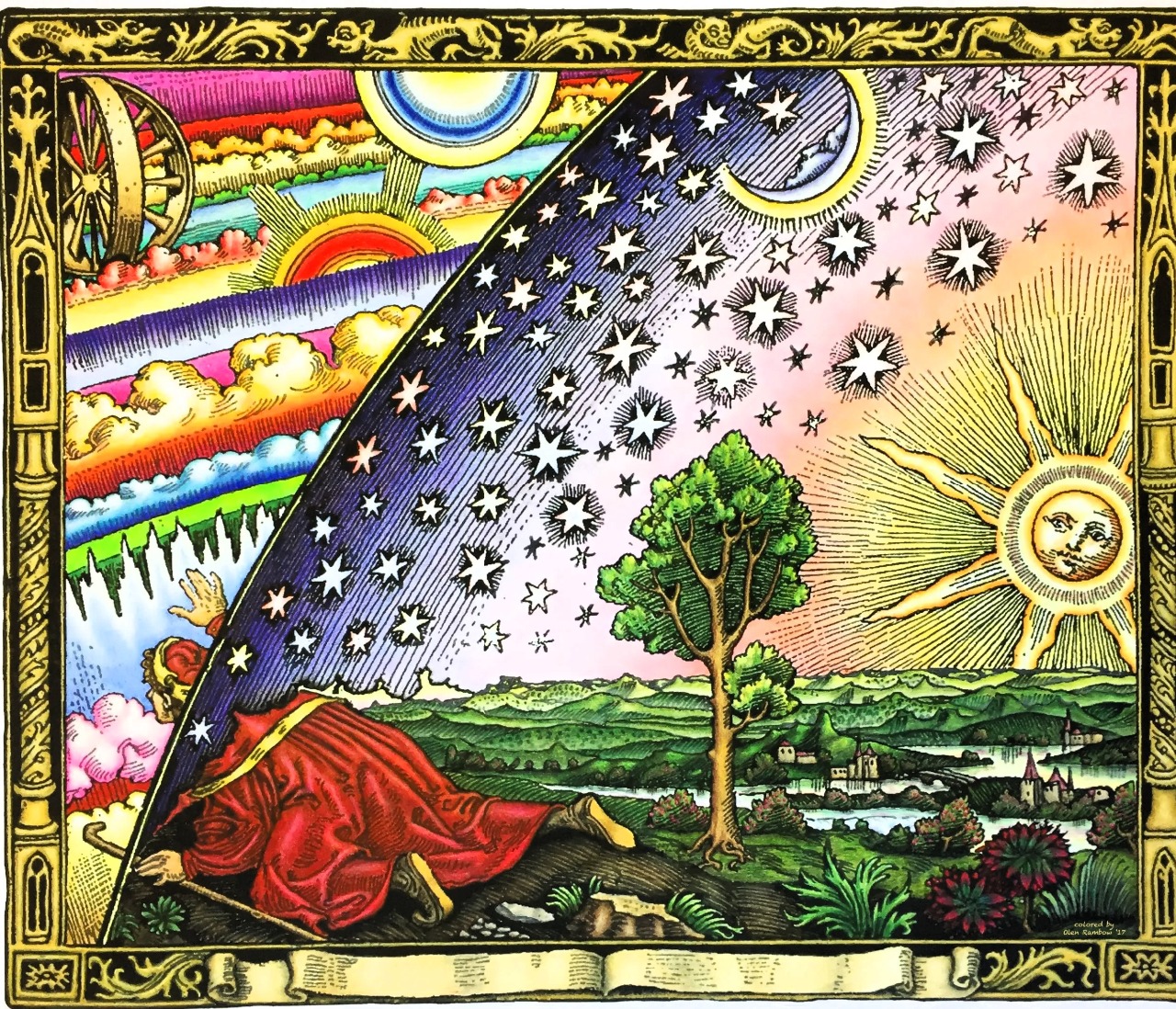
Such speculations were by the influential Augustine of Hippo (354 - 430) linked with Christianity and thus gave rise to the view of original sin that he championed, among other things, in his monumental work De civitate Dei contra paganos, On the City of God Against the Pagans.
Augustine was a well-read man and before he found Jesus Christ he had been an unsatisfied seeker. Augustine had gone to Rome to further his knowledge of the classical writings. At that time he was a Manichaean, i.e. a follower of a Persian religion founded by the prophet Mani (216 - 274). A strictly ascetic doctrine considereding evil to be a separate force involved in a constant struggle against good. Augustine enthusiastically embraced the teachings of Mani, until he delved into the writings of Plotinus (d. 270) and began to lean towards an idea that evil was in fact merely the absence of goodness and therefore not a force in itself. For nine years, Austin was a Manichaean until he was converted to Christianity by Bishop Ambrose of Milan and baptized. He then served as bishop in the North African city of Hippo.
Augustine’s view of original sin was aired in a polemic he conducted against Pelagius (390 - 418) regarding what could actually lead to the salvation of our souls. According to Pelagius, man was completely free to choose between evil and good - nothing prevented us from being able to make such a choice by virtue of our personality. Sin was caused by “evil” or wrong choices. The gist was that it was possible for a human being to live sinless – there was no original sin or other damage in human nature. The newborn child was free from sin and baptism was thus not a liberation from any inherited burden of sin.
Augustine did believe that it was still possible for an individual to choose the good. But it was extremely difficult and could only be done on rare occasions. It was a question of overcoming concupiscence, by which Augustine meant “the tendency to sin”, meaning that desire weakened our willpower. According to Augustine, the fight against our drives, especially the sexual drive, was extremely difficult win because it was waged against the terrible legacy of the Fall, which had been implanted in every human being since the beginning of time. Since Adam and Eve were expelled from Paradise, all of humanity has been helplessly caught in the web of desire. Something that has become as natural as breathing, as sleeping. We are born sinful. The only thing that can save us is God’s grace.
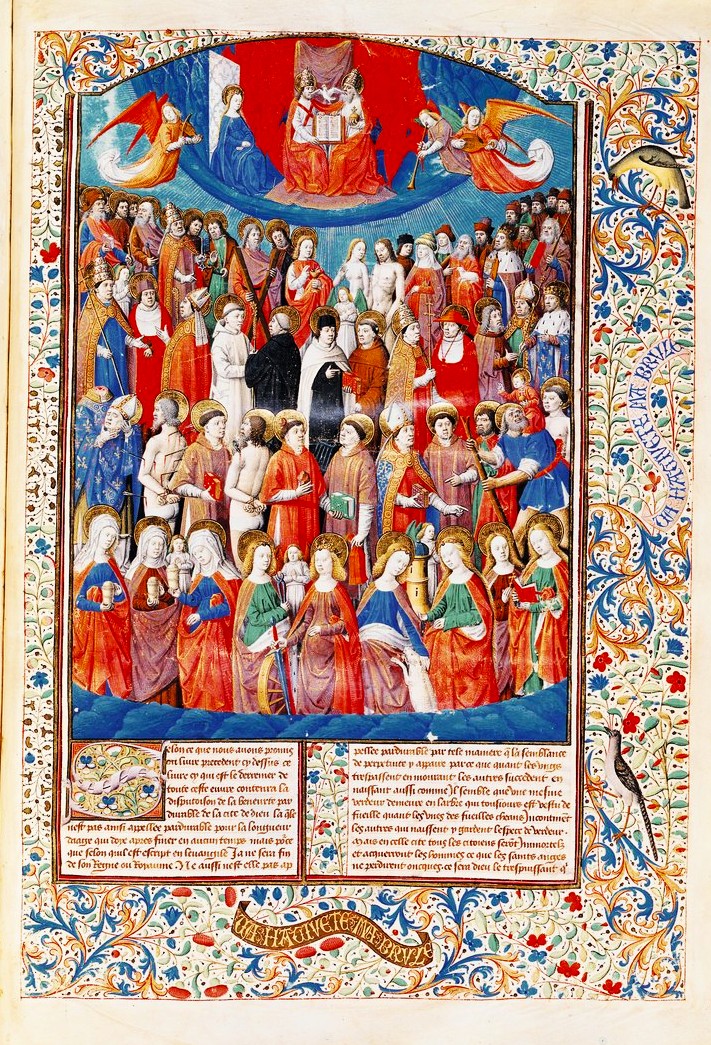
There is not much we humans can do about original sin. Luther gave us the idea of an omnipotent and omniscient God who controlled both all the evil and goodness that exist in the world and within all people. The main message of Luther, and several other reformers, was based on the teachings of Augustine and St. Paul. The latter wrote in his Epistle to the Ephesians, “for it is by grace you have been saved, through faith—and this is not from yourselves, it is the gift of God – not by works, so that no one can boast.” According to Luther, this meant that God had predestined certain people to receive his grace. Luther, unlike Erasmus and other humanists, believed that man’s will was limited, that God foresaw and controlled everything that happened. Luther’s starting point was that all people wanted to come to God and that if man truly had free will, all would be believers, though that was unfortunately not the case.
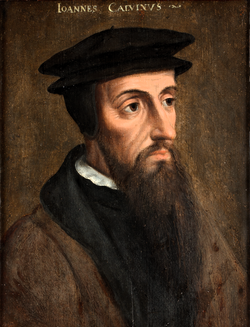
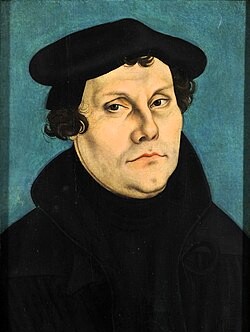
I cannot escape the thought that supporters of the doctrine of predestination down deep within themselves assumed that they were exemplary pious men, chosen by God to preach his doctrine to subsequently enter the Kingdom of Heaven. A thought that reeks of contempt for other people, especially when a predestination advocate like Luther advocated holy wars and a reformer who advocated predestination even more rabidly than Luther – John Calvin – exercised a reign of terror in Geneva. These two reformers detested each other and both opposed the humanist Erasmus, educated and knowledgeable in Greek like them. However, Erasmus was of a different breed, considerably milder and more tolerant and also an eloquent and skilled advocate for world peace, European community and an open, respectful debate.
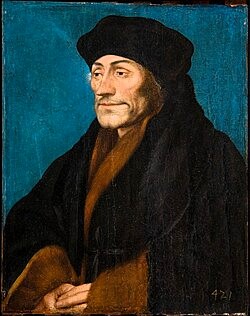
This provides me with the suspicion that both the extreme doctrine of predestination and the Christian belief in virginity find support and origin in self-overestimating male chauvinists who do not have much empathy for their opponents. If this is then spiced up with misogyny, the combination becomes fatal for women’s liberation from religious bigotry. “Grace through faith alone” was for centuries the official teaching of Swedish state-supported Lutheranism, but some bishops, such as the linguist and theologian Jesper Swedberg (1653 – 1735), whom I admire, were irritated by what he called The Big Faith, a belief that denied people their free will and ability to perform good deeds.
A faith of the brain and not of the heart, a shadow without a body, a dead and not living faith, yes … a devilish faith, that I am inclined to call the Big Faith, which Christianity swims along, May God have mercy on us all.
Even if Swedberg, like his fascinating son Emanuel Swedenborg, saw himself surrounded by angels and demons, he was in many ways a pioneer. Swedberg sought wider and better literacy among the Swedish common people and in his sermons he often attacked the frivolity and misrule of the nobility.
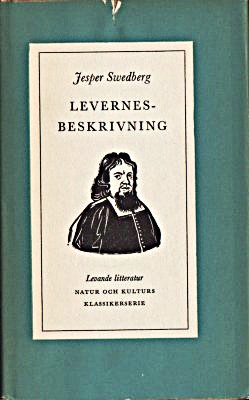
As mentioned, the Church Fathers’ belief in original sin brought much misery with it, in particular when it came to the Church’s view of women. These theologians believed that the soul died through lust and the body rottted in death. Spiritual corruption reflected bodily decay. In our pursuit of salvation and righteousness, we cannot help but sense the stench of our sinful bodies. And who was the cause of all this misery? – The seductive Eve. Augustine knew this, as he in his youth had taken a mistress, without marrying her. His involuntary sexual urge gad not been mitigated by any willpower, and Augustine had thus become entangled in the web of sin. It was all Adam's fault, no – not really … it was actually Eve who had arisen the passion in him! It was not the sexual act itself that was sinful according to Augustine, God had after all commanded humans to multiply, it was the sexual passion that was sinful, it was had blinded Augustine in his search for heavenly bliss.
Augustine was certainly no more rabid in his hatred of the mother of humanity, and thus all other seductive women, than many of his more or less contemporary theologians. It was quite common to listen to vitriolic attacks on women who, through their beauty and the adornment of their bodies, led men to ruin. When it came to the fight for the salvation of the soul, women were certainly on the side of the flesh. Saint John Chrysostom, “The Golden Tongue”, did not mince his words when it came to drawing the attention of believers to seductresses.
The beauty of woman is the greatest snare. Or rather, not the beauty of woman, but unchastened gazing! For we should not accuse the objects, but ourselves, and our own carelessness. […] The whole of her body is nothing less than phlegm, blood, bile, rheum and the fluid of digested food … If you consider what is stored up behind those lovely eyes, the angle of the nose, the mouth and the cheeks you will agree that the well-proportioned body is only a whitened sepulchre.
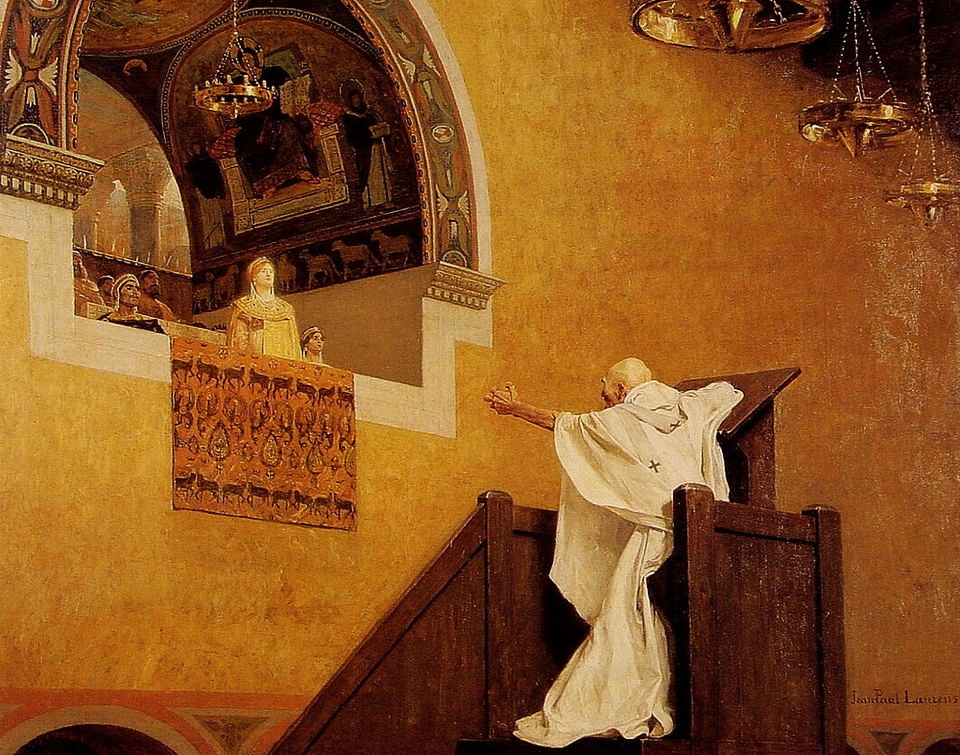
If Eve’s womb, and the wombs of the countless women who populated the earth after her, had been so corrupt, then at last a lightening came through the appearance of Jesus Christ on earth. Since he was an immaculate divinity, he must have grown within an immaculate womb. The Virgin Mary was thus be cosidered as “the Second Eve”, mother of us all, though her womb, unlike Eve’s, was pure, immaculate, sealed, and sanctified by the Holy Spirit. As Saint Jerome wrote, “Through Eve came death, through Mary – life.”
Jesus was God himself and had come to earth through the agency of a perfect woman. Through the Virgin Mary, original sin was erased. The only catch was that if her virginity and immaculate conception were a fact, it meant that other women and their wombs were and remained impure. It also meant that if a woman abstained from sex, from procreation and childbirth, her womb was closed and she would not pass on any original sin.
Paul believed that the world had been destroyed by the Fall, which had opened the gates to death, corruption and Satan's rule over the earth. Nevertheless ... just as road signs tend to proclaim, especially in the USA, … Satan's power will soon be broken by the second coming of Christ and people’s faith in him. The reign of evil, which was based on the certainty of death, both physical and mental, will suffer a tangible and universal defeat. And this would happen soon. Had not Jesus procimed “truly I tell you, some who are standing here will not taste death before they see the Son of Man coming in his kingdom”? Accordingly, Paul's advice and admonitions were only valid for a limited time. It is worth noting, however, that Paul did not actually recommend a state of permanent virginity if you are burning with desire.

It is good for a man not to have sexual relations with a woman. But since sexual immorality is occurring, each man should have sexual relations with his own wife, and each woman with her own husband. The husband should fulfill his marital duty to his wife, and likewise the wife to her husband. The wife does not have authority over her own body but yields it to her husband. In the same way, the husband does not have authority over his own body but yields it to his wife. […] I say this as a concession, not as a command. I wish that all of you were as I am. But each of you has your own gift from God; one has this gift, another has that. […] Now to the unmarried and the widows I say: It is good for them to stay unmarried, as I do. But if they cannot control themselves, they should marry, for it is better to marry than to burn with passion.
Speculations and theories about the birth of Jesus were endless and continued for centuries. How had Jesus' conception taken place and how had his birth taken place without the hymen of the vagina being damaged? Sometimes the explanations were purely physical, something that is witnessed, for example, in a curious sculpture on the portal in Würzburg's Marienkapalle where we can see how Jesus' fetus travels along a kind of tube from God's mouth into Mary's ear.
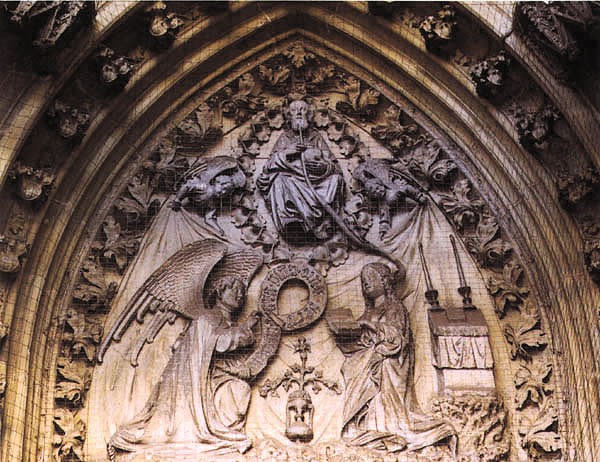
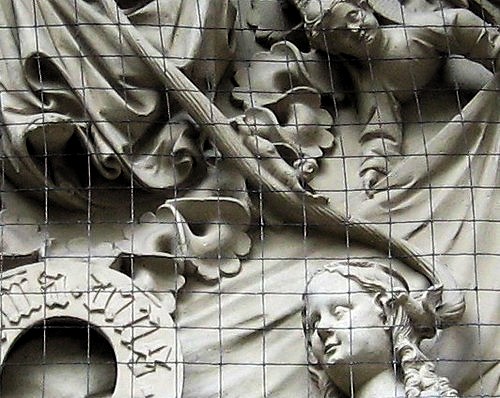
However, there are several spiritual, more miraculous descriptions of Jesus’ birth. The vision that Sweden’s saint, Birgitta, had after she visited the Church of the Nativity in Bethlehem in 1372 became particularly famous. Birgitta’s description, empathetic and picturesque as it was, came to have great significance for several artists and it may therefore be worth reproducing:
When I was present by the manger of the Lord in Bethlehem I beheld a Virgin of extreme beauty wrapped in a white mantle and a delicate tunic through which I perceived her virginal body. With her was an old man of great honesty and they had with them an ox and ass. These entered the cave and the man having tied them to the manger went out and brought in to the Virgin a lighted candle which having done he again went outside so as not to be present at the birth. […] Then, her hands extended and her eyes fixed on the sky she stood as in an ecstasy, lost in contemplation, in a rapture of divine sweetness. And while she stood thus in prayer I saw the Child in her womb move; suddenly in a moment she gave birth to her own Son from whom radiated such ineffable light and splendour that the sun was not comparable to it while the divine light totally annihilated the material light of St. Joseph’s candle. So sudden and instantaneous was this birth that I could neither discover nor discern by what means it had occurred. All of a sudden I saw the glorious Infant lying on the ground naked and shining. His body pure from any soil or impurity. […] Then, as the Child was whining and trembling from the cold and hardness of the floor where He was lying, He stretched out His arms imploring her to raise Him to the warmth of her maternal love. So His Mother took Him in her arms, pressed Him to her breast and cheek, and warmed Him with great joy and tender compassion.
One of the many interpretations of this vision was made, for example, by Fillipo Lippi and Hugo van der Goes, who excellently depicts the helpless, naked child lying directly on the ground.
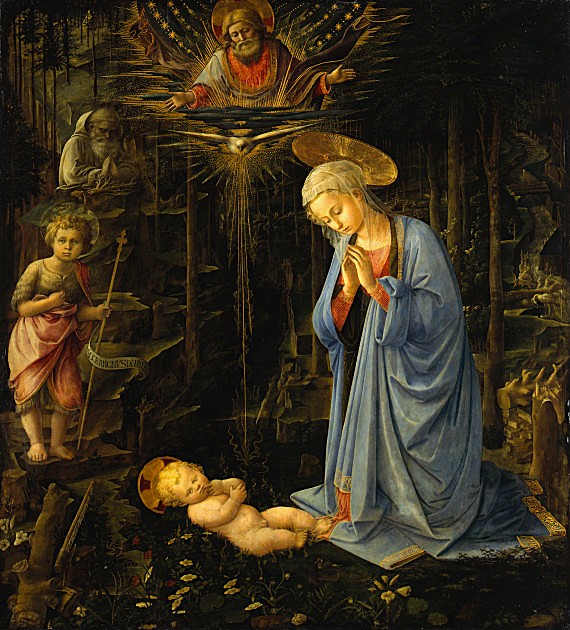
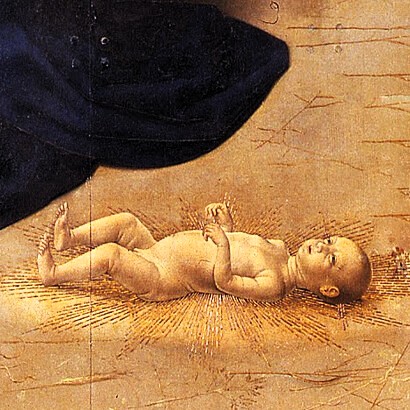
The writing about the birth of Jesus that, apart from those included in the New Testament, has become the standard when it comes to Mary’s virgin birth is the so-called Gospel of James (or Protoevangelium of James). An apocryphal gospel from the second century that tells of the miraculous birth of Jesus by the Virgin Mary, her upbringing and marriage to Joseph, the couple's journey to Bethlehem, the birth of Jesus and the events immediately afterwards. It contains the earliest preserved claim to Mary's perpetual virginity, which means that she was a virgin not only before the birth of Jesus, but also afterwards (the copies of the gospels that have been found so far date from a later period). Although the Gospel of James (in which Jesus, for example, appears as a mischievous, uncontrollable child) was condemned by Pope Innocent I in 405 and classified as apocryphal and dubious in 500, the gospel became an influential source for everything related to the birth of Jesus and the virginity of Mary. Over 100 Greek manuscripts have been preserved, and translations were made into Syriac, Ethiopic, Sahidic, Coptic, Georgian, Old Church Slavonic, Armenian, Arabic and probably also Latin.
It is for eample in James that we find that Mary rode a donkey and that there was an ox in the cave (not the stable) where she gave birth to her child. He also tells an unusually dramatic story about Mary's virginity. When Mary suffered from labour pains, Joseph rushed out to find a midwife who could assist his young wife
And the midwife went with him. And they stood in front of the cave, and a bright cloud overshadowed the cave. And the midwife said, “My soul is magnified today, because my eyes have seen something wonderful. Salvation has been born to Israel!”And immediately the cloud withdrew from the cave, and a great light appeared in the cave, so that their eyes couldn’t bear it. And a little later, the light withdrew until an infant appeared. And he came and took the breast of his mother, Mary. And the midwife cried out and said, “How great today is for me, that I’ve seen this new miracle!” And the midwife went out from the cave, and Salome met her. And she said to her, “Salome, Salome, I have to describe a new sight to you. A virgin has given birth, which is against her nature!” And Salome said, “As the Lord my God lives, unless I examine her condition, I won’t believe that the virgin has given birth.” And the midwife went in and said, “Mary, position yourself, because there’s no small test coming concerning you.” And Salome examined her. And Salome cried out and said, “Woe because of my lawlessness and my unbelief! Because I’ve tested the living God, and look! My hand is on fire and falling away from me!” And she dropped to her knees before the Lord, saying, “God of my ancestors, remember me, that I’ve descended from Abraham, Isaac, and Jacob. Don’t make an example of me to the people of Israel, but give me the back to the poor, because you know, Lord, that in your name I’ve healed people, and I’ve received my wages from you.” And look! An angel of the Lord appeared, saying to her, “Salome, Salome, the Lord of All has heard your prayer. Bring your hand to the child and lift him up, and you’ll receive salvation and joy.” And Salome joyfully went to the child and lifted him up, saying, “I worship him, because a great king has been born to Israel.” And immediately Salome was healed, and she left the cave justified.
In a painting from 1420, the Flemish Robert Campin described the drama. The newborn Jesus lies on the ground while Salome shows her withered hand to her friend, while the saving angel comes floating down from heaven and assures Salome, through his text strip, that she will be cured.
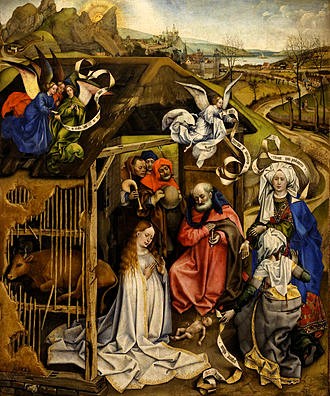
Even worse things happened to Salome in an illustrated prayer book from around 1500, where the poor Salome has had both her hands cut off, but the angel comes flying with a new pair.
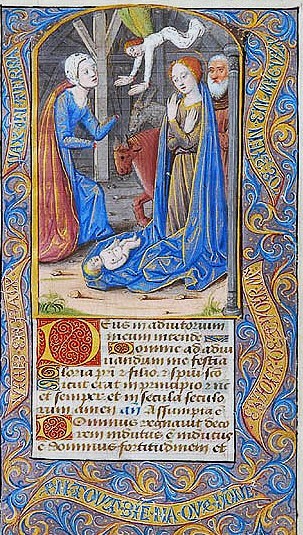
Several non-Christian writers and philosophers were amazed at the Christian nonsense about the great importance of virginity. Most of what pagan Greek and Roman writers wrote about Christianity has been lost; burned and destroyed by thevictorious Christianity. Fragments of the extremely critical Celsus, however, have been preserved through what the church father Origen (185 – 253) reproduced in his attacks on the pagans. Origen’s extensive quotations came from Celsus’ writing l’Alethesis logos, The True Word, in which he, often quite wittily, criticized Judaism and Christianity. According to Origen, Celsus took offense at the Christian virgin speculations in a mocking manner and even had the audacity to put forward the malicious slander that Mary was conceived by a Roman soldier named Panthera.
The Bible translator and church father Jerome, whom I mentioned in my previous blog post, was undeniably one of history’s most rabid advocates of virginity. He is also one of the few early Christians who come quite close to us, especially through his unusually extensive correspondence and many writings. Not everything has been preserved, thouigh what has been preserved is considerable and has exercised a great influence throughout the ages. For some reason, Jerome seems to be the saint who, with the possible exception of Saint Francis, is most ferquently depicted in the history of Western art.
Saint Jerome is then shown either in his studio, intensely writing and surrounded by his books. He is often dressed as a Catholic cardinal, which he never was, but suggesting that he was for a time the perconal secretary of the powerful Bishop Damasus. Since the seventh century, Jerome has generally been accompanied by a lion. Legend has it that obtain its gratitude after, like Androcles in a popular ancient tale, he pulled a thorn from its paw. The lion probably appeared because Jerome wrote a short story (which gives some fine insights into life in his contemporary Syria) about a chaste, Christian farmer and his equally chaste wife who were saved after they hid in a cave whose resident lioness spared them, but killed their pursuers.
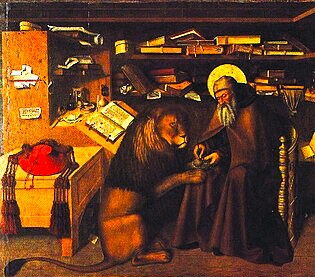
Alternatively, or simultaneously, several works of art depict Jerome’s time as a hermit, sometimes tormenting himself by beating a stone against his chest.
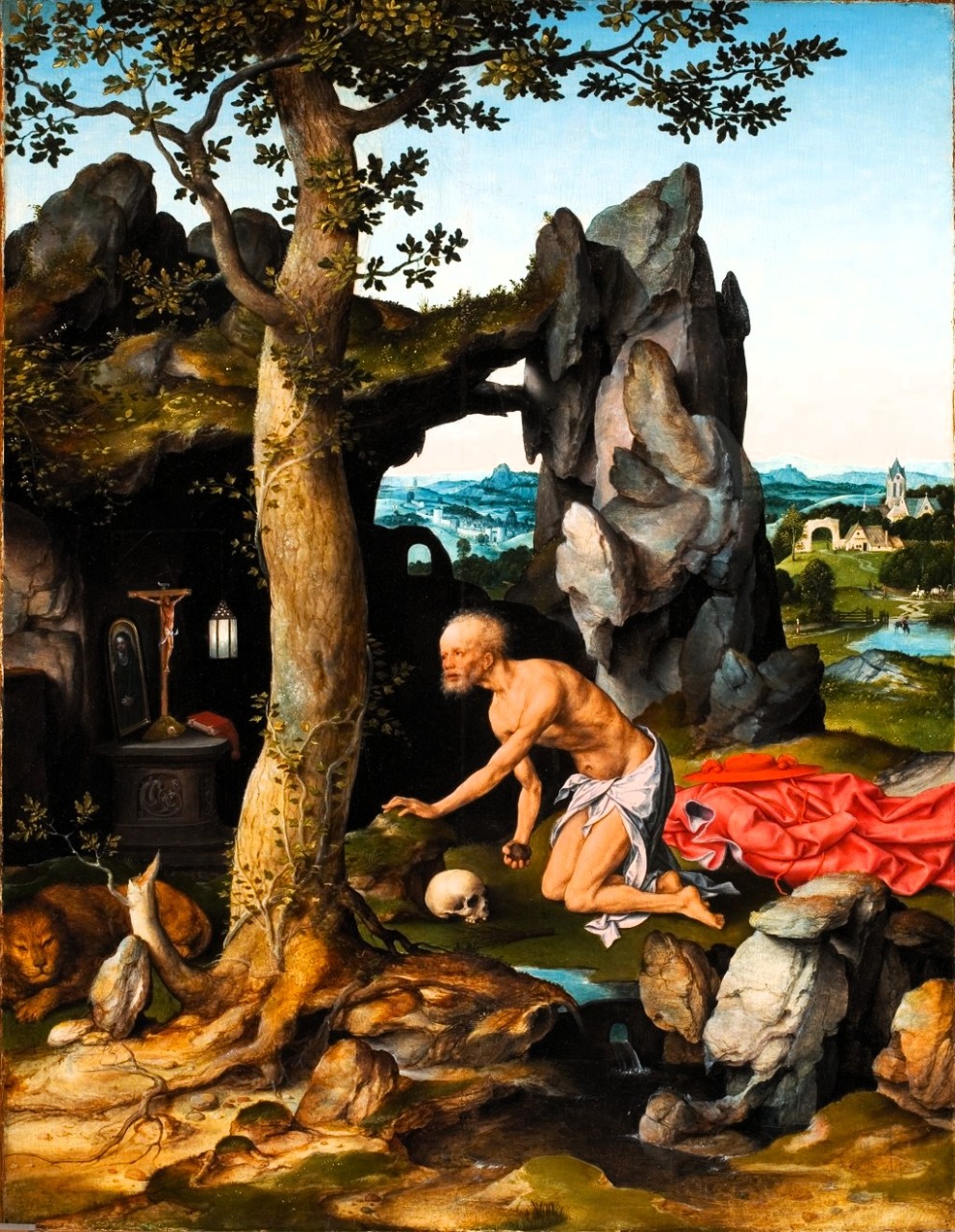
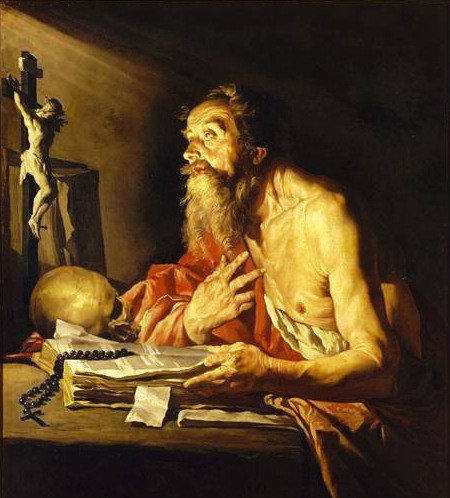
Jerome seems to have been a difficult person; easily irritated and angered, though he was a skilled writer, well acquainted with the classical Raoman and Greek tradition. His good friend Sulpicious Severeus wrote that
He is always reading, always buried in books he does not rest day or night he is always either reading something or writing something
His constant studies hid Jerome's passions: his hysteria, his tendency to violence and a destructive sensuality that, according to him, constantly threatened his peace of mind. All this hidden behind his well-ordered book collection and the theological debates in which he was constantly involved. Easily irritated, Jerome could in his comprehensive correspondence unexpectedly get excited and rave about women whose loose hair swayed in the wind, or who put rouge on their lips. It might seem as if he had been born old and bitter. He hated women, except those who were virgins or lived a “chaste” life, and he could almost choke with horror at the thought of what was inside a woman’s body. Every thought of sex tormented him and he attacked men who engaged fonication, or even flirtation, activites extremely distasteful to him. He even considered that calling a girl “honey” (actually mel meum, my honey) was a grave sin.
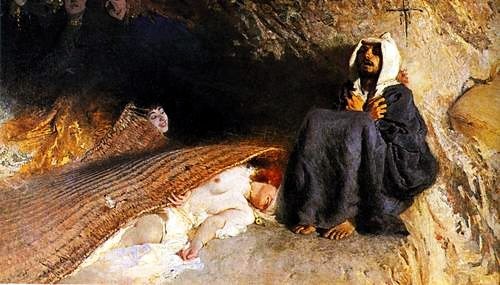
Jerome was born around 342 in Stridon, a now-vanished village somewhere in present-day Slovenia. He barely mentioned his parents. His father was a freed slave with some wealth, owning land and slaves. We know nothing about his mother, other than she, like his father, was a Christian. Jerome mentions a sister who in her youth had committed “a terrible sin” and occasionly he mentioned an aunt whom he hated for unknown reasons.
As a young man, Jerome came to Rome where he studied rhetoric and philosophy under the philologist Aelius Donatus and there came to be fluent in Latin and Greek. Donatus wrote several grammars and other textbooks on stylistics and rhetoric, He constituted an important link to classical scholarship and also wrote a popular biography of Virgil.
Jerome later confessed that during his youth in Rome he had engaged in superficial escapades and sexual experiments in comapany with other students. It had amused him for the moment, but afterwards he had been seized by terrible guilt feelings. To appease his conscience, Jerome visited the tombs of the martyrs in the catacombs and his experiences down there reminded him of the horrors of hell:
Often I would find myself entering those crypts, deep dug in the earth, with their walls on either side lined with the bodies of the dead, where everything was so dark that almost it seemed as though the Psalmist's words were fulfilled, “Let them go down quick into Hell.” Here and there the light, not entering in through windows, but filtering down from above through shafts, relieved the horror of the darkness. But again, as soon as you found yourself cautiously moving forward, the black night closed around, and there came to my mind the line of Virgil, “Horror ubique animos, simul ipsa silentia terrent” [Horror all around fills the mind, and at the same time the silence terrifies].
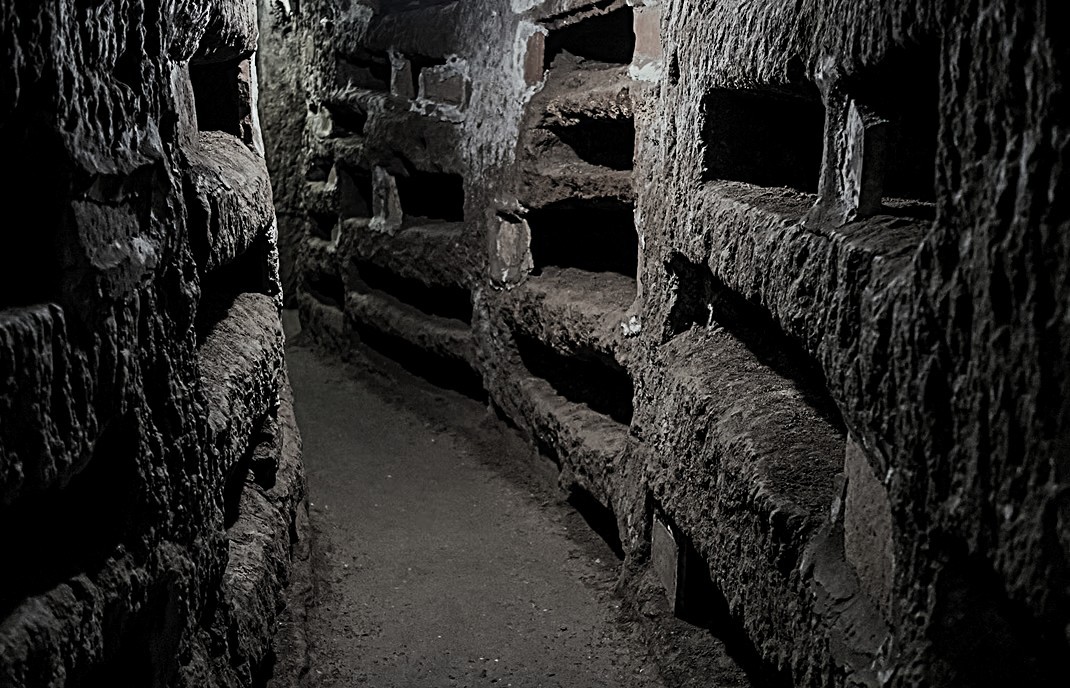
While he was carousing, Jerome was simultaneously seized by the admiration of his more pious friends. For example, his friend Rufinius was baptized, it was only several years later that they became bitter enemies. According to Jerome, Rufinius was a youth “pure as newly fallen snow”. The high esteem and unconditional admiration he felt for his young, pious and Christian friends became in the unbaptized Jerome a source for devastating self-contempt. He felt unworthy of a Christian baptism. He had sinned with his impure lips, “with my eyes, my feet, with all my limbs”. Once he had been baptized, this did not to help rid him of his self-accusations and he claimed that if he really deserved a true baptism, it had to be a second baptism, but “a baptism of fire because I have stained my baptismal cloak”. By this Jerome meant that he had stained his own body, since at that time the person being baptized stood naked in fornt of the baptising priest.
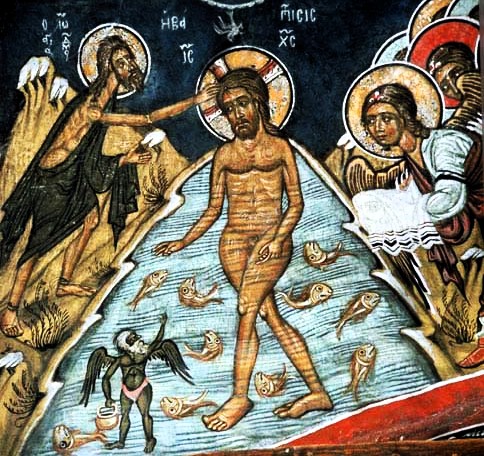
Together with another friend, Bonusus, Jerome traveled to Gaul and then followed him to the Dalmatian coast. Bosunus was a pious young man from a wealthy family and retired to live a hermit’s life on one of the barren Adriatic islands. However, he eventually gained quite a following, abandoned the hermit’s life and became a bishop. Unlike the fanatical virgin-worshipper Jerome, Bonusus denied Mary’s “perpetual virginity” and claimed that according to the Bible, Jesus had several siblings. This later led to Bonusus being excommunicated and losing his bishopry. However, he founded his own sect, the Bonusians, which survived for a couple of centuries. When he and his friend Bonusus retired to the latter’s Dalmatian island, Jerome found it difficult to adapt to the hermitical life. He envied Bonusus’ steadfastness but abandoned him on his island and went to the bustling port city of Aquileia, where they had mutual friends.
In Aquileia, Jerome associated with Heliodorus, a former officer who became a lifelong friend. Another close friend was Innocent, who encouraged Jerome to write, and Paul of Cyprus, who lived as a hermit just outside the city.

After some time the four friends decided to make a pilgrimage to Jerusalem. Rufinius came up from Rome to join them and together they wandered through Dalmatia, Thrace, Phrygia and Galatia until they reached Syrian Antioch, which at that time was an important Christian centre. There Innocent was seized with a violent fever and died after a short time. The friends decided to postpone their journey to Jerusalem and Jerome joined a community of hermits who lived far out in the rocky desert of Syria.
Now he wholeheartedly set about trying to discipline himself, especially by fighting his bodily desires. His body was weak and his struggle was difficult
vi är överallt omgivna av fientliga krafter, våra fiender finns överallt.Vårt kött är svagt och kommer snart att förvandlas till stoft; det kämpar mot enorma odds. Du kommer inte att vara säker förrän det har upplösts.
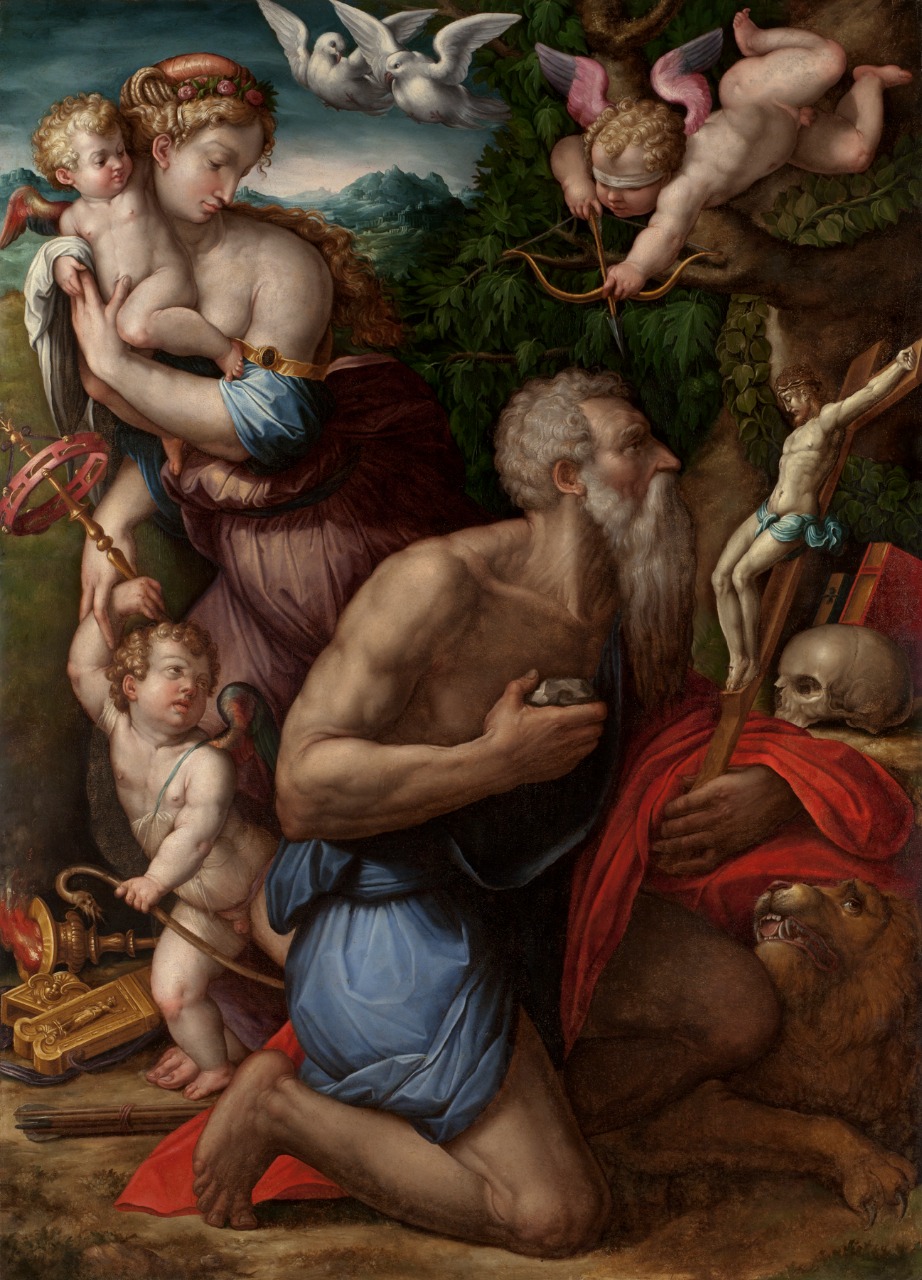
Öknen var ett i det närmaste skoningslöst hem för en eremit. Solen hettade upp alllting, skuggan var till föga hjälp. Hur ofta drömde sig Jerome inte tillbaka till Roms nöjen? Han grät och stönade.
I struggled to resist the misery, my bones, which scarcely hold together would knock against the bare earth and I will not talk about my food and drink: even if they are sick hermits only have cold water and cooked food is regarded as self-indulgence. .
In his fear of hell, Jerome had already condemned himself to a hellish existence here on earth. With only scorpions and wild animals for company, he imagined himself being courted by multitudes of young, seductive ladies.
No, some harsh asceticism was not good for Jerome. His desires, his body’s clamour for satisfaction, only worsened day by day.
My face was pale and my body cold from fasting, but my mind was aflame with desire and now that my flesh was as good as dead only the fires of lust boiled before me.
After his painful solitude in the barren desert, Jerome sought refuge with the other hermits and stayed with them, living in a bare and unbearably hot cell. Human company did not improve Jerome's miserable condition. He complained about how in the desert he had only had vermin for company but in the hermits’ monastery everything became increasingly worse. Several of his monastic brothers had become mentally disturbed by their harsh hermit life. Jerome found that too strict abstinence could damage the brain of people, especially if they lived in small, overheated cells. It happened that those who had become weak-minded from an overly strict regime did not know what they were doing, what they were saying, or what they should be silent about.
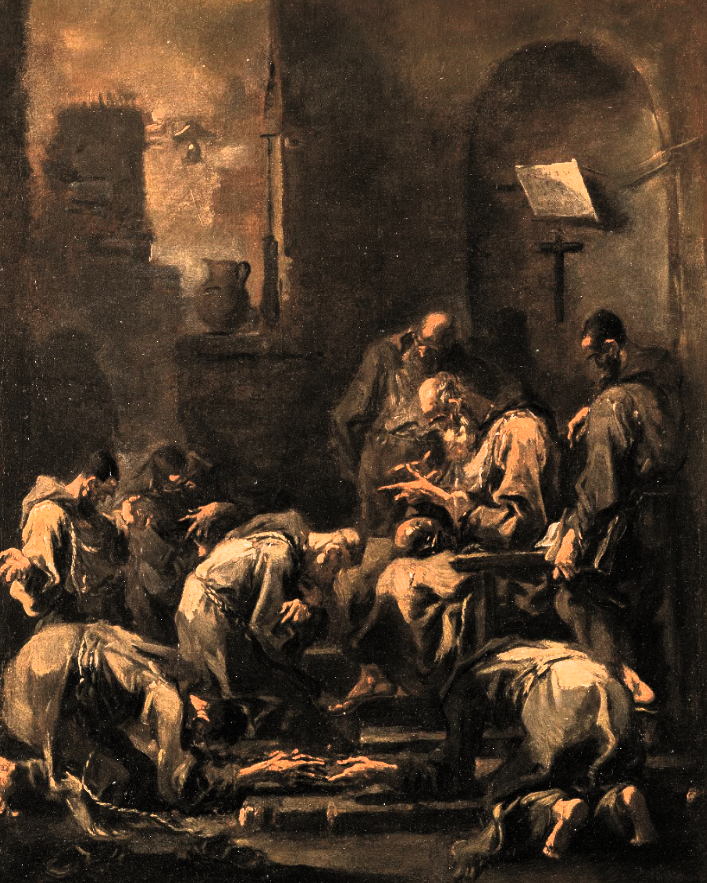
He learned that even far out in the desert there were such violent disagreements and discussions about the meaning of specific wordsìing that the hermits engaged in violent fights when they debated whether God was an ousia, a single divine being, or consisted of three hypostases, i.e. the fundamental states or substances that support all reality – the Father, the Son and the Holy Spirit. Jerome, who was already well-versed in Bible studies and extremely well-read, was tormented by his vulgar company – “Every day they ask me about my religious beliefs, as if I had been born again without faith. I confess to everything they wish.”
In fact, Jerome was tormented by ignorant people, both in the desert and in Rome.
Everyone thinks he can interpret the Bible. Gossipy old women, old men in their dotage, long-winded sophists, they all consider themselves as masters in the art, they tear the Scriptures apart and teach others what they have learned in the process. With knit brows and big words they philoosophize on the holy words to women. Other – oh the shame of it! - learn from women what they teach to men.
After being ordained in Antioch (he never exercised his priestly office), Jerome went to Constantinople and studied for a time under its archbishop, Gregory of Nazianzus. His choice was understandable. Already during his time in Rome, Jerome had developed a great admiration for Roman rhetoric and literature, especially Cicero, whose clear language he cherished. Under Gregory, Jerome also became better acquainted with the writings of Origen, on whose writings he wrote several commentaries. Origen (185-253), who was active in Alexandria, appealed to Jerome through his classical education and attempts to harmonize Christian thought with Roman and Greek philosophy, something that often led him to close to Gnosticism. Origen was also a philologist with considerable knowledge of Hebrew and Greek, which he used in his comparative studies of various biblical texts. Like Jerome, Origen also suffered from a strict and distorted sexual morality, and there are indications that he castrated himself. Origen was also one of the first to assert the Trinity, something that Jerome also believed in.
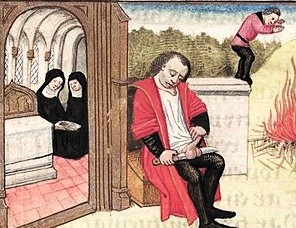
However, after a while Jerome abandoned his initially great admiration for Origen and became a rabid opponent of the spread of his texts. He complained that shiploads of his “blasphemies” were reaching Rome—“venomous and filthy doctrines that in Rome found a readership who willingly allowed itself to be led astray.” Among these “filthy” writings he counted the translation of Origen’s Peri Archon, On the First Principles. Perhaps Jerome’s aversion was due to the fact that, despite his sexual oddities, Origen, unlike the misanthrope Jerome, was actually an optimist. Origen did not believe in any original sin and accordingly not in the inherited guilt from Eve and did thus not concern himself with any reflections on the virginal purity of Mary. He believed in God’s forgiveness and benevolence and that humans would progressively free themselves from sin and evil. Even the Devil and his fallen angels would eventually be welcomed in Paradise.
Jerome had now tried the hardships of hermit life and immersed himself in Greek and Hebrew. In Antioch he had begun Hebrew studies with a rabbi and in Rome he would further improve himself in the language of the Old Testament with the help of a converted Jew. In Antioch and Constantinople Jerome had missed the library he had built up in Rome (probably a friend had taken care of it) and he felt it now was high time to return to the old capital of the Empire. Once there, his contacts brought him to the enterprising bBishop Damasus and he began his onerous Latin translation of both the Old and the New Testaments.
At first, Jerome was not entirely enthusiastic about the assignment. He had studied the Jewish and Christian scriptures in their original languages for several years, but found their language to be inferior compared to that written by Cicero and Virgil. As with most other things, Jerome was troubled by this. After all, had not the writers of the Bible been inspired by God – shouldn’t they then not have been as skilled writers as the Roman pagans?
The whole thing was resolved through a dramatic dream in which Jerome, after his cold, lifeless body had been buried and his soul carried up to the heavenly light by angels to be presented naked before the Judge’s tribunal. Naked and trembling, he was asked who and what he was. Jerome replied that he was a Christian, but then the seated Judge thundered:
You are lying! You are a Ciceron, not a Christian. Your treasure is where yoiur heart is.
In his dream Jerome was sentenced to severe punishment. Vroken and weak he thought: “Who will praise You from Hell” and swore before the Most High that henceforth he would not read any pagan writings, only those inspired by God and that he would put all his writing ability at the service of the Lord.
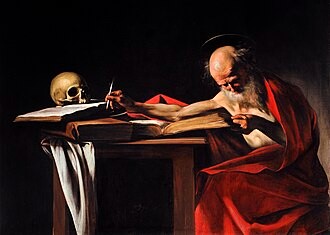
In Rome, Jerome became object of both admiration and malicious gossip. He was now a gifted orator, translator of the entire Bible, favorite of the powerful and fearsome Bishop Damasus and not least – close friend and teacher of several of Rome’s most distinguished and influential ladies, several of whom were quite wealthy. The list is long. There was Albina, a rich and noble widow, who with her widowed daughter Marcella lived in a palace on the Aventine Hill. Another very influential lady friend of Jerome was Marcelluina, sister of Bishop Ambrose of Milan, the most powerful man in the Empire, to whom even the emperor had to bow his knees. Jerome’s very special adept, with whom he was rumored to have had an “improper” relationship, was the wealthy but extremely ascetic Paula and her four daughters. There were also Paula Sophrinia, Felicita, Asella, Lea, and another Marcella.
Jerome’s influence on these ladies, whom he visited in their luxurious villas, attracted much attention and gave rise to “vile gossip in the slander-loving society of Rome”. A city that, according to Jerome, rewarded “immorality and where good people are objects of slander, where everything that is pure and innocent is driven into corruption”.
People wondered about Jerome’s relationship with his lady friends and he wrote that he was laughed at for praising adepts who were “only women”. He defended himself by saying that he judged a person solely on the basis of their character and did not care at all about their sex. Furthermore, through his long and extensive studies, “which, so to speak, had become part of my nature”, as well as his lifelong meditations, Jerome had found to his surprise that he was best understood by women, who through their isolation had become more inclined than men to absorb what he taught and taught.
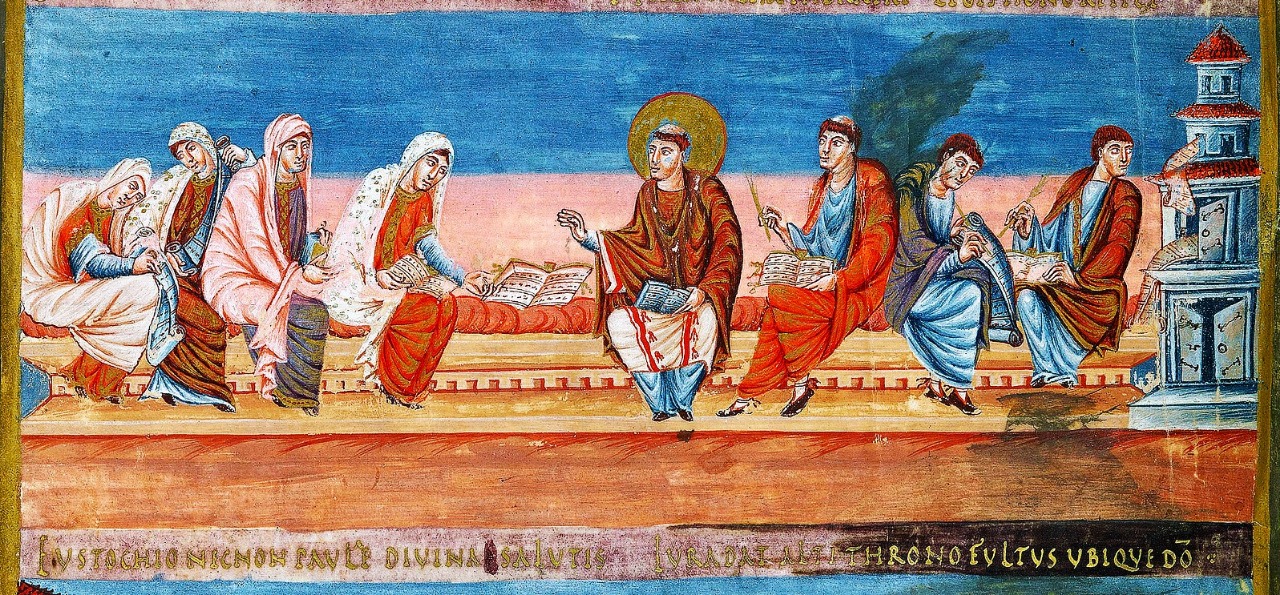
When Jerome later convinced his beloved Paula’s daughter, Eustochium, with his flowing eloquence and a torrent of biblical quotations, to preserve her virginity at all costs and through rock-hard asceticism, he railed against the snobbish priests who infiltrated the homes of rich ladies, warning Eustochium against
Men of my own order- who are keen to become priests and deacons only so that they may visit women without restrictions. All they care about is their clothes and whether they smell nice and whether their feet fits smootly in their shoes. Their hair is curled and still shows traces of of the tongs, their fingers are covered in glittering rings and they walk along on tiptoes so that their feet do not get splashed in the wet streets. […] Some of them devout their whole life and all their efforts to knowing the names, houses and characters of married women.
Such a man
hastens to rise with the sun; he knows exactly in what order to make his morning calls; this old man takes a short cut and barges more or less straight into the bedrooms of women who are still asleep. If he sees a cushion, or an elegant tablecloth, or any little piece of furniture, he admires and praises it, as he handles it, lamenting that he has nothing like this. In this way he does not so much ask for it as extort it from the owner, because all the women are afraid to offend this cunning old fox. He cannot bear castity or fasting; what he likes is a tasty meal with a plump chicken, usually known as a “cheeper” pipizo. He has a rude an impertinent way of talking and is always armed with abuse. well sprinlkled with words of abuseWherever uyou go he is the first person you see. What ever piece of news is going around,m he is the one who either frist reported it or who exaggerated it the story. He changes horses every hour – in fat, his horses are so sleek, so spiritted that you migt think he was the brother of the king of Thrace.
Rhesus, a king of Thrace mentioned in the Iliad, was known to have had the most beautiful horses in the world. By “horses” Jerome seems to mean “opinions”.
![]()
Was descriptions like the one above perhaps a disguised self-image? This is not the only place where An early legend, possibly related to a supposed homosexual inclination of Hieronomys, suggested that he was accused of transvestism. A related story is that while he was sleeping in his cell, a demon entered and replaced his male attire with women's clothing, unaware of which Hieronomys dressed and entered the congregation dressed as a woman, thereby causing great scandal. railed against effeminate men, while with a disguised jealousy praising pious youths “pure as newly fallen snow”. Perhaps Jerome’s absurd praise of chastity and virginity might be explained by reference to a guilty laden and ill-concealed homosexuality?
An early legend, possibly related to a supposed homosexual inclination of Jerome, suggested that he was accused of transvestism. A related story mentions that while he was sleeping in his cell, a demon entered and replaced his male attire with women's clothing, unaware of the change Jerome entered the congregation dressed as a woman, thereby causing great scandal.
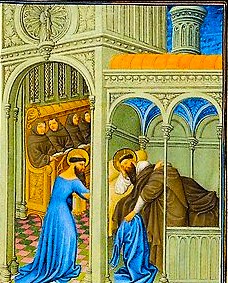
His frequent and voluptuously eloquent depictions of a flamboyant, refined clergy make me think of the witty Swedish cabaret artist Karl Gerhard, who in 1922 made a great success with his The Jazz Boy.
With rhythmically swaying hips,
we boys make our entré.
Our pants are pressured,
our ankles noble,
our posture somewhat blasé,
with a promising gaze.
Well, here comes a boy,
his pants are like a razor sharp.
He has his suede shoes on
and his hobby is to dance the jazz.
He is slim and thin as a willow,
smiling softly
with curls upon his brow.
He and other cute boys,
have ink on their eyelids,
and after feasting on pastries
can be seen at Royal at five o' clock.
As jazz expert
he trips on high heels,
and to small syncopations
he sways his little bum.
https://www.youtube.com/watch?v=Xk3GPiFlvaA
Karl Gerhard was married three times, but in later years he lived with his secretary and “rignhyt-hand man”, Göthe Ericsson. There is now no doubt that the great and otherwise unusually bold King of of Swedish enterainment (he was one of the few how dared to infuriate and ridcule the Nazis in songs and words) was homosexual and that he in his Jazz Boy, in a way that is undeniably similar to Hieronymos, was revealing his own disposition. Like Hieronymos, Karl Gerhard also wrote openly about his weakness for handsome men, for example his lifelong friend, the celebrated actor Gösta Ekman
a far too handsome young man, who would probably have been unbearable, if his handsome boyish features had not been illuminated by something that was both pain and opposition.
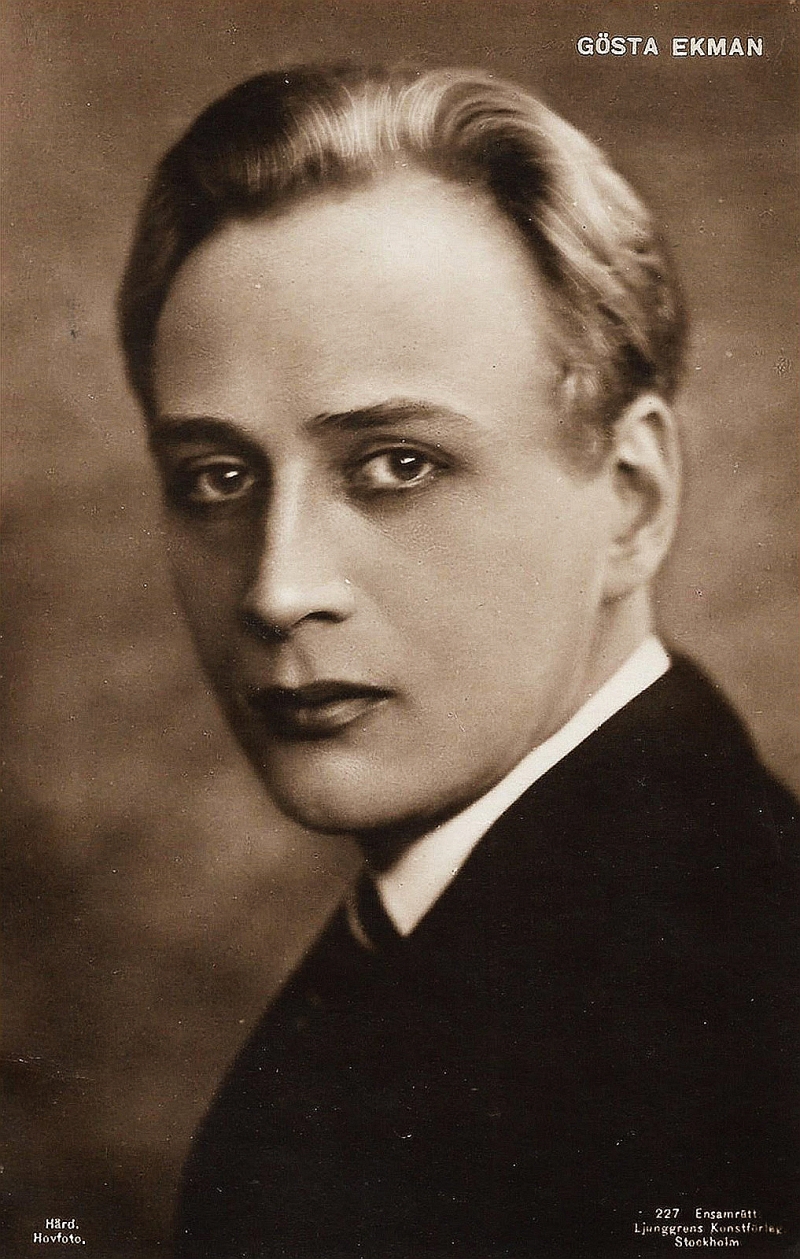

Hieronymos also mentions a completely different type of parasite; filthy ascetics, who bare-legged, while carrying heavy chais and clad in foul-smelling rags, clambered into the salons of pious ladies. The feet of these ostentatious ascetics were “blue from a holy cold” and they adorned themselve with, long, matted beards: “If there is any holiness in a filthy beard, there is nothing holier than a goat.”
If he attacked Rome’s frivolous priestly sycophants and stinking ascetics, Jerome was even more contemptuous while attacking the wealthy ladies who wasted their time on bodily beauty; bathing, applying make-up, and adorning themselves with jewelry:
They paint their faces with rouge and white lead, dress in flashy silk clothes, wear sparkling jewels and gold necklaces, while hanging their most expensive Red Sea pearls from their pierced ears. They surround themselves with a perfumed aroma of musk. Such women end up wishing to rid themselves of male domination and go in serach of new husbands, not to serve them, as God wills, but to dominate them. Accordingly, they seek out men who are less well off, but who have the advantage of being husbands in name only, men who know they have to put up with rivals, because if they grumble they will be kicked out immedieately.
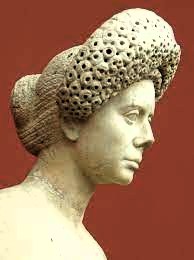
Most wealthy Christian ladies were not much better, rather worse. Inflated by their husbands’ successes, they surrounded themselves with eunuchs and syncopants, while being dressed in tunics woven with gold thread. Their skin was plump and their lips red. The villas where they idly spent their days were filled with admirers, not least a fawning clergy who submissively praised them as if they were chaste nuns, even though they wished for their husbands’ premature deaths so they could inherit their fortune. Such seemingly pious ladies pretended to fast, but ate at night when they had been awakened by the belching from their indigestion. When they set out for church, rows of eunuchs walked in front of their closed palanquins, but when they, together with their retinue, entered the hallowed environ they openly distributed their alms so that all might witness and admire their generosity and saintly piety.
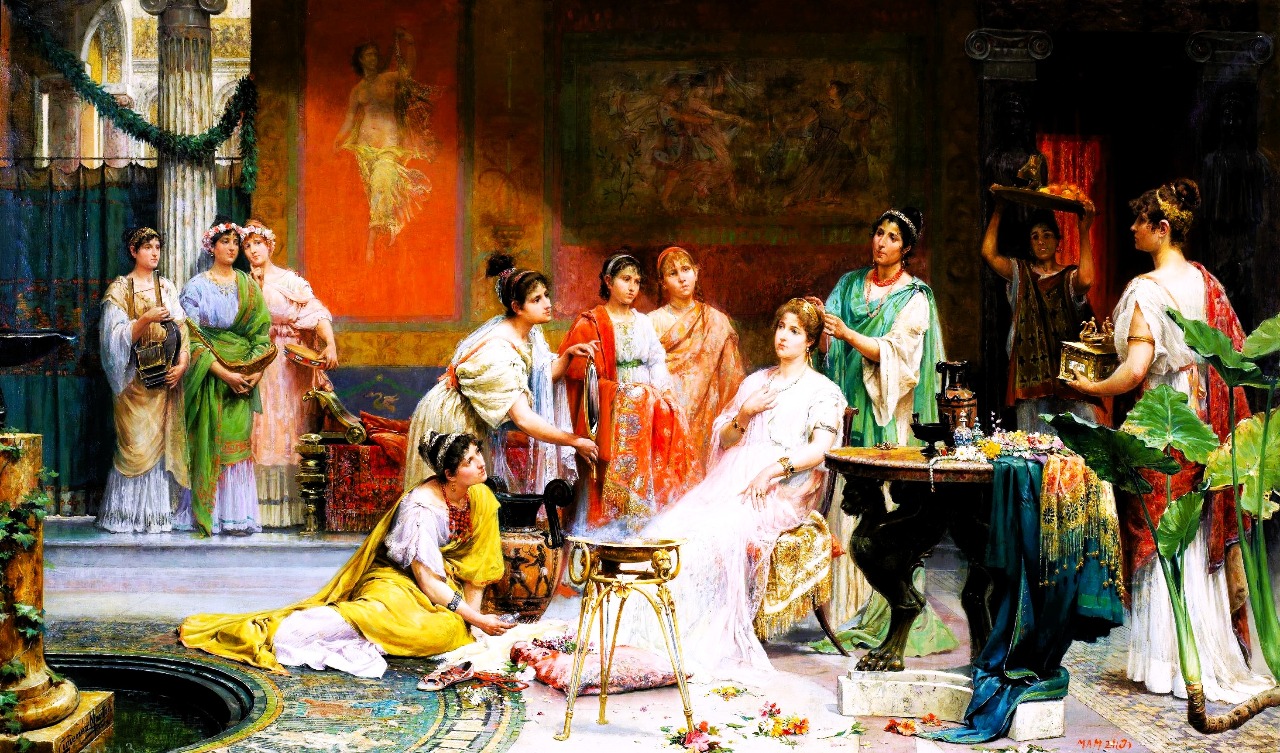
However, there were exceptions and it was among wealthy ladies that the ascetic, pious, and learned Jerome made his inroads, preaching a strict doctrine of renunciation, abstinence and virginity. Several devout ladies gathered and socialized with one of their friends, for example Jerome found his first female acquaintances with a group of women who lived in monastery-like conditions in Albina's villa.
These women seem to have been driven by a genuine thirst for knowledge, possibly due to the fact that they were denied the education that wealthy households traditionally devoted to boys, while girls were excluded from such acquisition of knowledge. It was there that the knowledgeable Jerome could be of service and teach the women his view of the teachings of the Bible and he was certainly one of Rome's absolute experts in the field.
Perhaps within these female coteries, despite the emphasis they placed on simple clothing, unpainted faces, strict diets and rare baths, a certain homosexual attraction might be present. Given how much Jerome disliked men who addressed their beloved with endearing words, it may seem surprising how extravagant his female protégés could express themselves among themselves, as when Paula and her daughter Eustochium tried to persuade Marcella to come to them and Jerome in Bethlehem. In their letter to her, they prayed to God and explained that
We must do the the only thing people who are seperated can do; we pour out our deperate entreaties, making You aware of our longing, not just with tears but with sobs, in the hope that You will give us back our dear Marcella and not allow that gentle lady, that kind lady sweater than the sweatest honey, to be stern with us or frown at those who were inspired her friendliness to try to live a life like hers.

About the same Marcella, Jerome wrote to her friend Principia that he had heard that after he had left Rome
you immedately took my place beside her and never moved even a hair’s breadth, so to speak, from her side, using the same house, the same bedroom, even the same bed, so that everyone in that famous city got to know that you had found a mother and se a daughter. Her estate at the edge of the sity became a monastry for you both.
Jerome’s virgin cult was undoubtedly connected to these pious women who had isolated themselves from the surrounding society to undisturbed devote themselves to Bible studies and strict asceticism. This was primarily an urban phenomenon. Women could not become priests, but they could neither as hermits go out into the wilderness, where thei in their defenseless solitude ran the risk of being abuse and/or raped. Women were therefore forced to stay within the cities and then often under the protection of other women, who could count on their own wealth and/or the protection of a powerful priesthood.
Unlike a male body, a virgin’s body was perceived as a tangible manifestation of physical and spiritual purity. It had not been defiled by sexual intercourse, or childbirth, and unlike a male hermit a virgin did not have to prove to the outside world that mental struggle and harsh physical discipline had made them worthy of God’s and that they furthermore were pure and innocent. If a young woman swore before God and the Christian community that she was and would forever remain a virgin, she could earn the respect of a congeration and even more than a priest be asked for intercessions before God, the Virgin Mary, Jesus and other immaculate heavenly beings. In this manner, virginity could also become a refuge for women who wanted to avoid forced marriages, repeated and difficult pregnancies,combined the common risk of death in childbirth. Just as what had been the case with the women assembled around Albina and Marcella in Rome, they could share their lives together, in peace and quiet, at the same time as they immersed themselves in studies, which otherwise would have been denied them. Gradually, such “communities of Christian sisters” developed into women’s monasteries, which originated in Bethlehem where Jerome’s beloved Paula, under his supervision, established strictly regulated monasteries for both men and women.
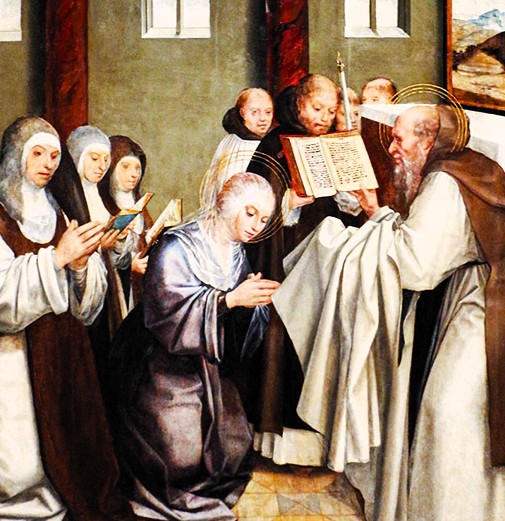
Paula was from the beginning one of the women Jerome liked to criticize. A noble lady who traced her ancestry back to a number of venerable senators. She was member of the influential family of Furii Camilim, which originated from Marcus Camullius who in the 4th century BC had conquered the Etruscan city of Veii and who considered himself to be a descendant of the Iliad’s Agamemnon.
Paula lived a luxurious life in several villas, dressed in gold and silk and was by her eunuchs carried in a palanquin through the city. When she was 37 years old, her husband died and left her with his fortune. Paula's piety deepened even further and she became a leader in the semi-monastic group who had gathered around Marcella.
Under the influence of Jerome, Paula became increasingly ascetic, engagimg in strict fasting and self-torture in such an obvious way that the aristocracy of Rome believed that Jerome, like an evil Rasputin, had began to rule and deal with her and other wealthy ladies in such a way that the entire city came to suffer from his outrageous behaviour.
When one of Paula's daughters, Blaesilla, died in 384, Jerome was accused of having caused her death through his strict regime. Things got even worse when he declared that the mourning for Blaesilla was excessive – she had lived a righteous life and should not be mourned.
When Jerome's patron, the feared Bishop Damasus, died that same year, Jerome was forced to leave the city and settle in Jerusalem. Shortly afterwards, Paula and her daughter Eustochium left Rome to join Jerome in the Holy Land. Paula left her children and took her fortune with her, while announcing that she would not leave a single sestertius to her children. Instead, she would spend her entire fortune on God's work of salvation. In his biography of Paola, Jerome gives a dramatic account of her departure:
The sails were already stretched taut when the ship was being rowed out to deeper water, when little Toxotius, standing on the shore, stretched his arms out to her begging her to stay, while Rufina, who had already reached marriageable age, deplored her mother with tears rather than words to wait until she was married, But Paula remained dry-eyed, her gaze fixed on heaven.

In Bethlehem, Paula organized her monastic communities according to Jerome's strict rules. All women who gained entry were to be chaste and preferably young virgins. They were kept isolated with prayer and Bible studies.
If any of the young girls became excited by thoughts of sex, Paula would crush these tendencies by prescribing frequent and doubled fasts. She preferred that the girls have stomach aches rather than disturbing thoughts.
If one of the girls in proved to be too talkative, foolish and frivolous, the strict Paula separated her from the others for a longer time. Paula’s monastic rules were, like herself, harsh and gloomy.
There is already something wrong here. Why should the girls be disciplined? Why were they not allowed to have fun and amuse themselves? For the sake of their souls’ salvation? Why should they already from their early youth be forced to live a quite miserable life? Were they locked up and subdued as a preparation for an extremely uncertain future after death? Was it really worth destroying young lives in this way? The logic is flawed.
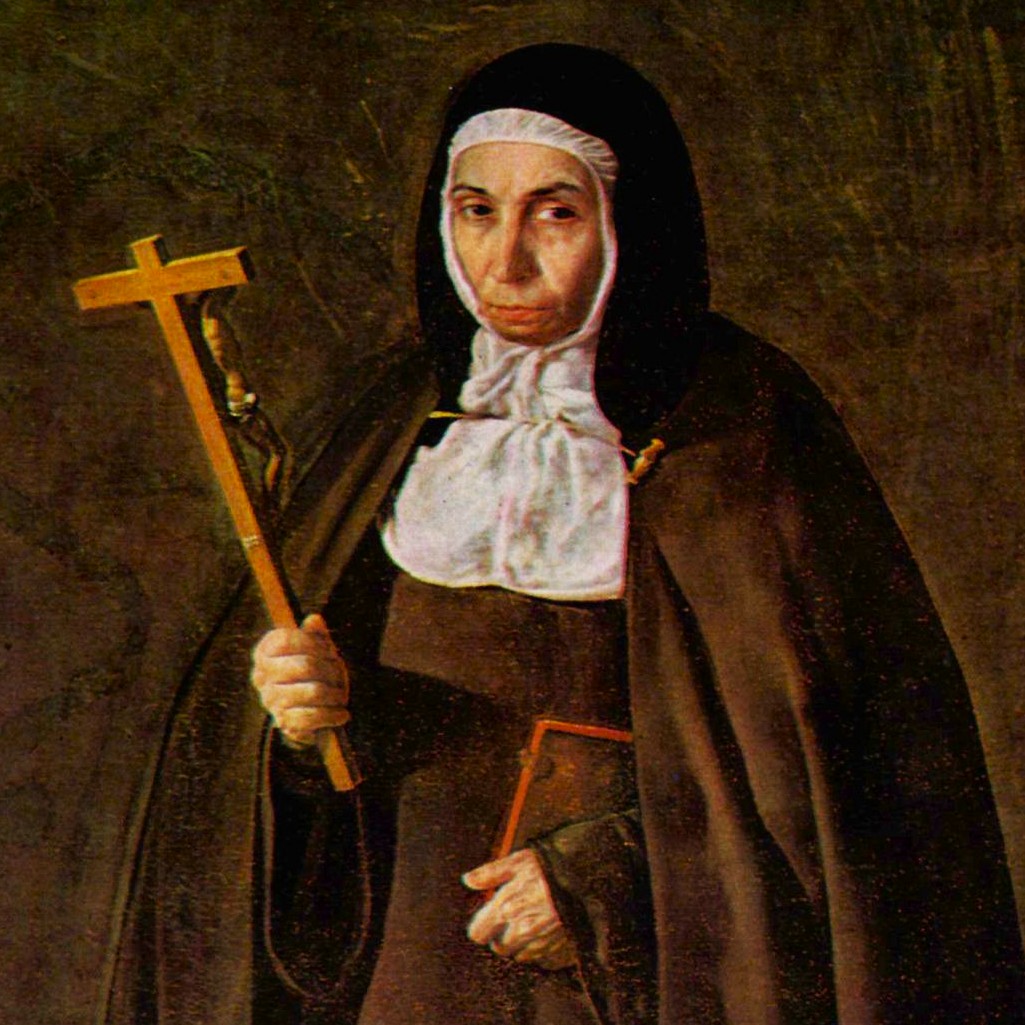
Jerome was deeply attached to Paula and those who knew him said that she had been a good influence on the old curmudgeon. An acquaintance of his murmured that after Paula’s death there was no one left who could would be able to manage Jerome’ bad temper. He was known for being unusually unforgiving and fiery in both speech and writings. When he went on the attack, he did so by all means available to him and tried to destroy his enemies with erudition, rhetorics and his vast knowledge of languages, often spiced with a weakness for vulgar invectives.
An example of his debating syle is the polemics he used while attacking a certain Onasus from Segesta, who apparently had an unusually large nose. The assault began with Hieronymos stating that surgeons occasionally were forced to perform horrific operations to be able to save a patient’s life, such as cutting off diseased, or repulsive, limbs. Jerome then turned against Onasus, who for some unknown reason had reported Hieronymos to the legal authorities.
According to Hieronymos, Onasus filled his cheeks with air, as if they had been bladders, while balancing hollow phrases on his tongue, which after he had expelled them turned out to be nothing more than stale breath. Onasus had achieved his social position through crime, perjury and false pretense, and this was the reasom to why Hieronymos could heartily laugh at Onasus’ inept lawyer, who himself was in dire need of a defender and whose eloquence was little more than a foul-smelling fart. Then Jerome amused himself with Onasu's name, which meant “the helpful one”, a contradiction on a par with calling the Furies Angels of Mercy and the Roman custom of calling “negroes silver boys”. Jerome ended his diatribes by giving such a disgustingly ugly person as Onasu some pieces of good advice:
There are some things you must hide, if you are to appear handsome. Let your nose not be seen upon your face and let your tongue never be heard in conversation. Then you may possibly be thought both good-looking and eloquent.
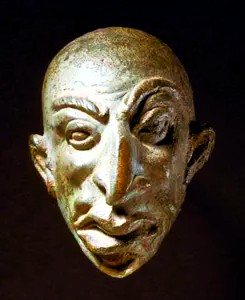
When Paula died, Hieronymos mourned her deeply:
Farewell, Paula: please pray for me in my final years, I who idolize you. Your faith and your works unite yiu with Christ and so, face to face with him, yiu will easilygain what you ask for.
It was Eustochium who now had to put up with the demanding Jerome. He had previously written a long and in many ways frightening letter to the then seventeen-year-old girl – On Choosing a Life of Virginity”. In a text packed with biblical quotes, Jerome described how young, beautiful women are forced to live surrounded by evil powers and insidious men. This made it hard and difficult for a pious woman like Eustochium to protect her virginity and avoid all the tricks and traps that lurked around her. She should certainly not believe that marriage and motherhood were a way out of this earthly misery. Jerome wrote that he did not want to repeat all the unpleasantries of marriage, but could still not refrain from mentioning some of them.
the swollen belly, the crying baby, the pain caused by your husband’s mistres, the anxieties involved in running a household and all those imagined advanteages which death at last cuts short.
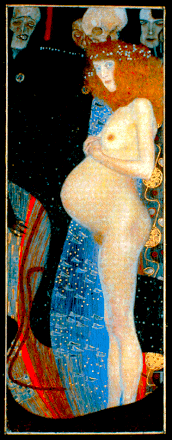
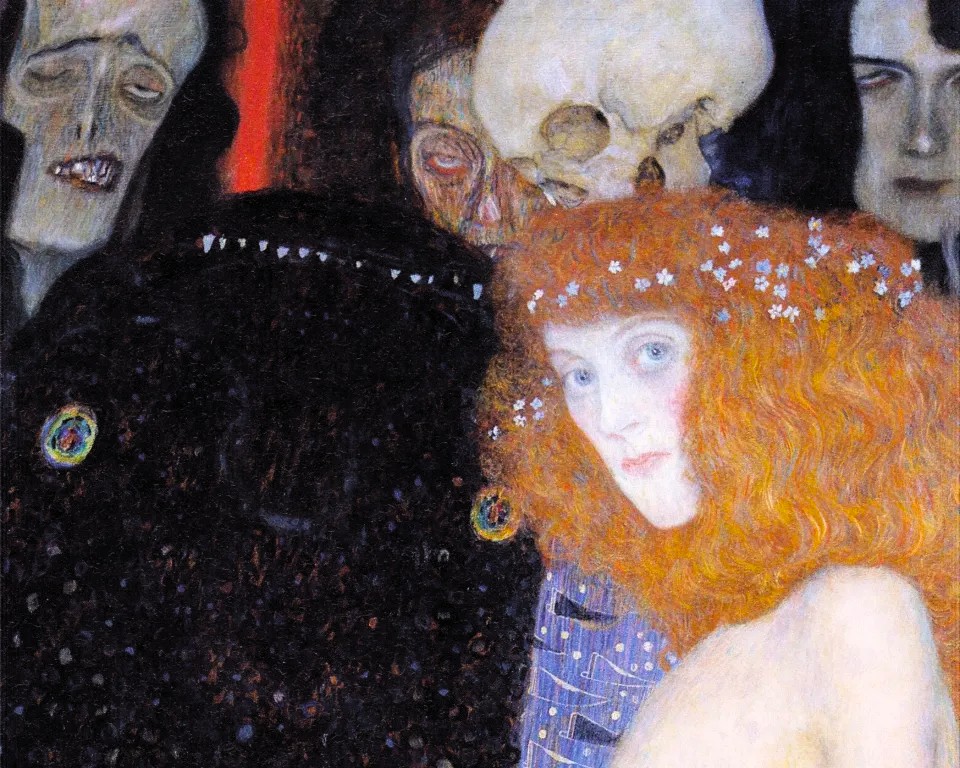
To stay pure and remain the bride of Christ, Eustochium should avoid the company of married women and stay far away from young men. She should beautify herself through makeup and other unnatural means, beauty fades. Sje is already beautiful, but women age quickly, especially if they have a man by their side. However, Eustochium should not exaggerate her asceticism to such a degree that she wore her torments as a badge of honor. Like the old hags who disfigured themselves only to appear as ascetic saints. She should not gorge herself on delicacies, because if she went to bed after a hearty meal, exciting erotic dreams would appear. Jerome knew this from his own experience. When he left Rome, it was with a treacherous thought about all the good meals he would miss. No, it was better to go to bed with a hunger that was not completely satisfied. Generally speaking it would be advisable ones sleep as much as possible. So, Eustochium – Keep to your room, pray and study!
In many ways, Jerome’s advice was dangerous for a young woman. He triumphantly wrote that he had saved many women, especially by discouraging them from sex and marriage:
As long as woman is for birth and children, she is different from man as body is from soul. But if she wishes to serve Christ more than the world, then she will cease to be a woman and will be called man.
When he smugly stated that several of the women in his care had become like men, it was not only because they had become Jerome’s equals in education and piety, but also because several of them had experienced that after their hard ascetism their menstruation had ceased. Severe fasting and lack of sleep might lead to amenorrhea, cessation of menstruation, a condition that in young women vcause severe anorexia nervosa, meaning that menstruation never returns.
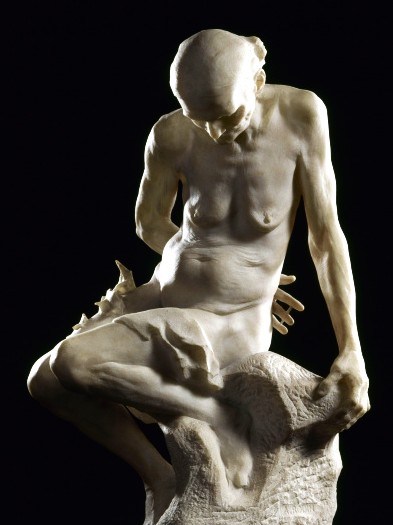
Biased bible interpreters, male chauvinists and sexually obsessed saints, such as Jerome, have by all accounts had an enormous impact on the emergence of the Western cult of virgins. Early theologians transformed Christianity from having been a quite straightforward doctrine about our common responsibility for our fellow human beings; the great importance of compassion and love for the well-being of humankind. They succeded’in cerating a tangled, hair-splitting philosophy in which Mary's virginity came to have a decisive significance. This fuelled the subjugation of women to patriarchy, arbitrary misogyny and a reign of terror over young women and their bodies.
I remember how in my youth once found myself in a pious setting dominiated by a group of vociferous young women who enthusiastically praised the Catholic monastic system, which according to them had liberated women from male oppression and fostered their mental development. What a relief it must have been for a medieval woman to enter a monastic peace that had created role models such as Saint Bridget, Hildegard of Bingen, Saint Teresa of Avila and so many other intellectual and combative women. Peace and peace? – Prayers and meditations, loneliness and frustration, rules and oppression of body and soul. A prison for young women who had not followed their fathers’ will to marry disgusting men, who had rebelled against the oppression of patriarchy, or who had proven to be generally troublesome. Misogyny in the guise of faith, a twisted belief system legitimized by strange dogma about Mary's virginity.
I stood in front of the mosaic of the Virgin in Chiesa di Santa Maria Regina Pacis and wondered how this peculiar worship of the Virgin could have persisted into “our enlightened age”. Mistero della Fede, Mystery of Faith.
After two thousand years, the virginity of Mary continues to be a cornerstone of the Catholic Church
Finally, the Immaculate Virgin preserved free from all stain of original sin, when the course of her earthly life was finished, was taken up body and soul into heavenly glory, and exalted by the Lord as Queen over all things, so that she might be the more fully conformed to her Son, the Lord of lords and conqueror of sin and death.
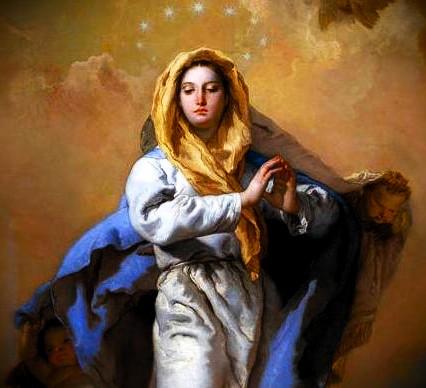
Virginity is still a Catholic ideal, but the concept has been softened and is now mostly often identified with “chastity”, i.e.
The successful integration of sexuality within the person and thus the inner unity of man in his bodily and spiritual being.
Which means that you should not become a victim of your passions, but always have the salvation of your soul and respect for your fellow human beings in mind. Chastity has thus moved from being exclusively applied to sexual celibacy to include marriage as well.
However, celibacy still applies to those men and women who have chosen to live as virgins for the “Kingdom of Heaven” and with an “undivided heart”. Men and women who have consecrated themselves to the Lord, sacrificed themselves to preach and carry out the Lord’s commandments.
Chastity and celibacy are something that the Catholic Church also recommends for homosexuals. The Catholic Catechism states that homosexuals have not chosen
their condition; for most it is a trial. They must be accepted with respect, compassion, and sensitivity.
Nevertheless, the Catechism does not hesitate to label homosexuality as being against the laws of nature, a deplorable disorder and thus a threat to sincere love and the “complementarity” between man and woman.
Homosexuals are thus “called” to chastity. Through strict self-control they should learn to achieve interior freedom, especially through the support of true friendship, prayer and participation in the Eucharisty. In this manner homosexuals might eventually overcome their harmful inclination and gradually and resolutely approach Christian perfection.
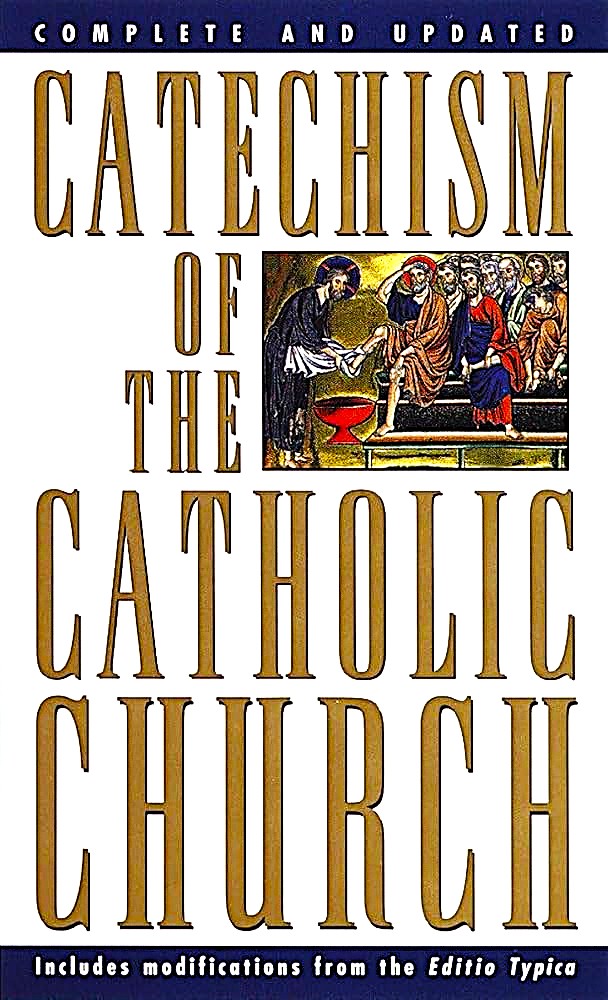
Several deeply religious Catholics have taken the advice of the Catechism and with great effort fought their homosexuality, occasionally by becoming nuns and priests, or by practicing absolute chastity in their private lives. This has often only led to anxiety and feelings of failure and rejection.
Some of these pious people have however celebrated their sense of liberation from the ensnaring web of sexuality by what they have described as a liberating practice of strict celibacy.
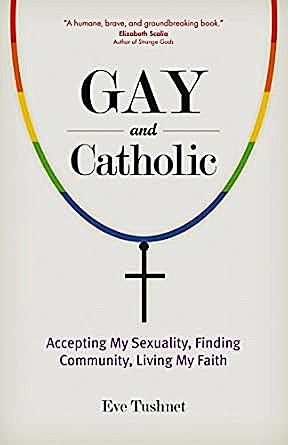
In any case, I believe that the Church's excessive and bigoted fixation on sexuality, chastity, virginity, and everything else in that genre has clouded what it claims to stand for – love, tolerance, and the forgiveness of sins.
Bridget (2016) The Prophecies and Revelations of Saint Bridget of Sweden Altenmünster: Jazzybee Verlag. Brown, Peter (2003) The Rise of Western Christendom. Malden MA: Blackwell. Hock, Ronald F. (1995) The Infancy Gospels of James and Thomas Polebridge MT: Polebridge Press. Holy See (1995) Catechism of Catholic Church. New York: Doubleday. Johnson, Paul (1980) A History of Christianity. London: Pelican Books. Nixey, Catherine (2024) Heresy: Jesus Christ and the other sons of God. London: Picador. Payne, Robert (1989) The Fathers of the Western Church. New York: Dorset Press. Tushnet, Eve (2014) Gay and Catholic: Accepting My Sexuality, Finding Community, Living My Faith . Notre Dame IND: Ave Maria Press. Walker, Benjamin (1990) Gnosticism: Its History and Influence. London: Harper Collins. Warner, Marina (1983) Alone of all Her Sex: The myth and the cult of the Virgin Mary. New York: Vintage. White, Carolinne, ed. (1998) Early Christian Lives. London: Penguin Classics. White, Carolinne, ed. (2010) Lives of Roman Christian Women. London: Penguin Classics.




.jpg)

.jpg)